2. 中国科学院地球科学研究院, 北京 100029;
3. 中国科学院大学, 北京 100049;
4. 中金黄金股份有限公司, 北京 100011;
5. 中南大学地球科学与信息物理学院, 有色金属成矿预测与地质环境监测教育部重点实验室, 长沙 410083;
6. 内蒙古有色地质矿业(集团)有限责任公司, 呼和浩特 010010
2. Innovation Academy for Earth Science, Chinese Academy of Sciences, Beijing 100029, China;
3. University of Chinese Academy of Sciences, Beijing 100049, China;
4. Zhongjin Gold Corporation Limited, Beijing 100011, China;
5. MOE Key Laboratory of Metallogenic Prediction of Nonferrous Metals and Geological Environment Monitoring, School of Geoscience and Info-Physics, Central South University, Changsha 410083, China;
6. Inner Mongolia Nonferrous Geological Mining Limited Liability Company, Hohhot 010010, China
作为铁镁质与长英质岩浆共生产出的双峰式岩浆建造之一,辉长岩-花岗岩系列几乎贯穿经典威尔逊板块构造旋回的各个阶段。一方面,欧洲加里东和海西造山带(Ferré and Leake, 2001; Bonin, 2004; Renna et al., 2006, 2013)、澳大利亚古生代拉克兰造山带(Turner et al., 1992; Kemp et al., 2005)、蒙古-鄂霍茨克中生代构造域(Yuan et al., 2019)和北美中新生代科迪勒拉造山带(Lindline et al., 2004)的典型案例表明,它们通常形成于造山后或非造山板内背景下的拉张环境。另一方面,它们间或发育于大洋板块俯冲阶段的诸多伸展环境;例如,华北克拉通北缘古元古代洋脊俯冲形成的拉斑质辉长苏长岩-Ⅰ型花岗岩建造(Peng et al., 2010),马达加斯加大陆弧后拉张催生的新元古代辉长岩-花岗岩组合(McMillan et al., 2003),西天山古亚洲洋板片回撤引起的晚石炭世辉绿岩-花岗岩组合(Tang et al., 2014),喜马拉雅造山带始新世特提斯洋壳板片断离形成的辉长岩-花岗岩杂岩(赵志丹等, 2011),华南造山带古太平洋板片断离诱发的早白垩世钙碱性辉长岩-Ⅰ型花岗岩系列(Li et al., 2012),日本冲绳海槽第四纪陆缘弧后盆地的玄武岩-流纹岩(Shinjo and Kato, 2000)以及南美洲南部与洋中脊俯冲相关的上新世双峰式碱性岩浆系列(Espinoza et al., 2008)。
这些遍及全球不同时期造山带的研究案例显示,辉长岩与花岗岩通常呈现多元化的成因关联:一是二者分别源自独立的地幔和地壳源区;二是辉长岩源自幔源玄武质岩浆结晶分异;三是花岗岩形成于幔源岩浆诱发的地壳物质重熔以及幔源玄武质岩浆与壳源岩浆的混合作用。这种多元的成因关联表明,辉长岩-花岗岩系列繁杂多样的岩石地球化学特征不仅记录了双峰式岩浆建造在潜在壳幔源区和岩浆形成条件等方面的区域性差别,而且蕴涵了区域构造伸展与复杂壳幔作用耦合联动的重要信息。因此,辉长岩-花岗岩系列是刻画岩浆产生-运移-侵位完整演化机理、示踪复杂壳幔相互作用、甄别区域伸展构造并反演区域威尔逊板块构造旋回等的重要探针型岩浆建造。
中亚造山带是联结东欧-西伯利亚克拉通和塔里木-华北克拉通的关键显生宙构造单元(图 1a)。其不仅记录了响应古亚洲洋裂解、俯冲与消亡的威尔逊造山旋回,而且造就了全球规模最大、历时最长的大陆增生场景(Şengör et al., 1993; Jahn, 2004; Windley et al., 2007)。作为学术界目前普遍认可的古亚洲洋终结之处(Xiao et al., 2003, 2015; Jian et al., 2010; Eizenhöfer et al., 2014; Eizenhöfer and Zhao, 2018; Zhao et al., 2018),内蒙古中部保存了一系列记录古亚洲洋构造域古生代构造变迁与地壳增生过程的蛇绿混杂建造、岛弧岩浆带和碰撞后/造山后岩浆岩省(张晓晖和翟明国, 2010)。这些物质记录既是检验中亚造山带大地构造增生演化不同范式的直接对象,也是评估以活动大陆边缘为中心的多旋回陆壳生长轨迹的理想介质(Jahn, 2004)。就整个造山带层次而言,代表性宏观范式包括“单一岩浆弧持续俯冲-增生”(Şengör et al., 1993; Yakubchuk, 2004)和“多岛洋俯冲-增生”(Windley et al., 2007; Xiao et al., 2015)。虽然现代太平洋型的多岛洋俯冲-增生范式近年来逐渐占据主导地位,诸多学者对于内蒙古中部古生代威尔逊造山旋回的精细过程及其岩浆响应序列的认识仍然不乏分歧。“早俯冲-晚裂谷模式”的倡议者认为,内蒙古中部发育的古亚洲洋在指示弧陆碰撞的晚志留-早泥盆世高钾钙碱性岩浆事件后消减殆尽,晚古生代岩浆活动主要归因于多期陆内裂谷(Xu et al., 2013, 2015; 邵济安等, 2014; Wang et al., 2016; 徐备等, 2018)。“多阶段俯冲模式”支持者则认为,古亚洲洋于晚二叠-早三叠世沿索伦缝合带最终闭合(Xiao et al., 2003, 2015; Jian et al., 2010; Eizenhöfer et al., 2014; Li et al., 2017; Eizenhöfer and Zhao, 2018; Zhao et al., 2018; Yuan et al., 2022),内蒙古中部早古生代岩浆序列见证了西太平洋型洋内俯冲体系的诞生、发展与成熟(Yuan et al., 2022),晚古生代岩浆序列则记录了安第斯弧型活动大陆边缘弧后盆地伸展-关闭、陆-弧碰撞、碰撞后伸展垮塌等一系列构造过程(Zhang et al., 2008, 2011; Eizenhöfer et al., 2014; Yuan et al., 2016, 2022; Eizenhöfer and Zhao, 2018; Jiang and Zhu, 2020; Yang et al., 2020; Li et al., 2021)。
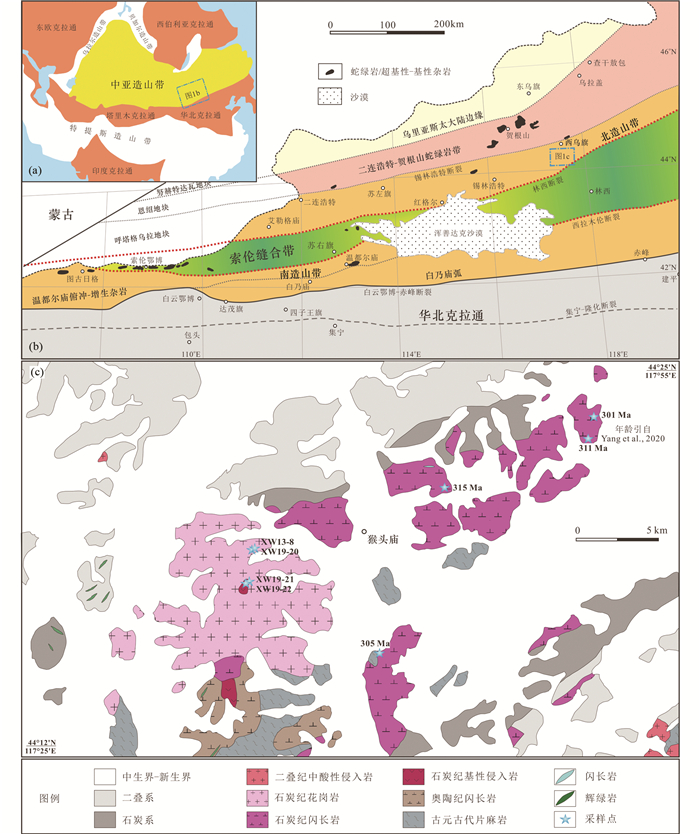
|
图 1 研究区所在位置与区域地质简图 (a)中亚地区构造简图(据Şengör et al., 1993); (b)内蒙古中部构造简图(据Badarch et al., 2002; Xiao et al., 2003; Jian et al., 2008修改),研究区域用矩形表示; (c)内蒙古中部西乌旗地区辉长岩和花岗岩岩体地质图(据中国地质调查局, 2005①修改),采样点用五角星表示 Fig. 1 The tectonic location of the study area and sketch geological maps (a)tectonic framework of Central Asia(after Şengör et al., 1993); (b)sketch geological map of central Inner Mongolia (modified after Badarch et al., 2002; Xiao et al., 2003; Jian et al., 2008), with the study area indicated by a rectangle; (c)sketch geological map for the gabbro-granite from West Ujimqin of central Inner Mongolia, with the sample locations indicated by pentagrams |
① 中国地质调查局(CGS). 2005. 内蒙古西乌珠穆沁旗幅1/250000地质图及附注
近年来一系列高精度测年和精细地球化学示踪工作陆续揭示,内蒙古中部古亚洲洋构造域地质记录在西乌旗地区最具代表,既保存了一系列年龄介于361~295Ma之间的蛇绿混杂岩(李英杰等, 2013, 2015; Song et al., 2015; Li et al., 2018, 2020),也见证了最重要的晚石炭世至早二叠世岩浆爆发幕(Zhang et al., 2008, 2021b, c; Liu et al., 2013; Yang et al., 2020)。类同于经典活动大陆边缘幕式岩浆活动(Collins et al., 2011; Ducea et al., 2015)的特点表明,该期岩浆爆发幕是重建活动大陆边缘弧后盆地裂解、板片回退、洋脊俯冲、板片断离、岩石圈拆沉等一系列威尔逊构造旋回关键节点的重要对象。例如,可能对应弧后盆地裂解到伸展成熟阶段的中-晚石炭世中性侵入岩系列(Yang et al., 2020)、可能响应后碰撞岩石圈拆沉的早二叠世双峰式火山岩(Zhang et al., 2008)和辉长岩-花岗岩组合(Zhang et al., 2021b, c)。在此基础上,本文拟报道在西乌旗地区新近识别的晚石炭世辉长岩-花岗岩系列,利用离子探针(SIMS)锆石U-Pb测年精确厘定其侵位时代,借助全岩元素地球化学和Sr-Nd同位素、锆石Hf-O同位素组成示踪其岩浆属性和岩石成因,并结合区域相关蛇绿岩套和活动大陆边缘火山-沉积序列研究结果,探讨晚石炭世双峰式岩浆活动发育的深部机制,进而重现内蒙古中部晚古生代弧-盆体系演化的地球动力学场景。
1 区域地质背景内蒙古中部位于中亚造山带东段兴蒙造山带区域(Şengör et al., 1993; Xiao et al., 2003),西联蒙古国南戈壁省,东接我国东北地区(图 1a)。在细节有别的当前主流中亚造山带东段构造区划方案中,内蒙古中部被一致三分为南北并置的两个复合陆块及位于其间的索伦缝合带(Xiao et al., 2003, 2018; Jian et al., 2008; Xu et al., 2013; Eizenhöfer and Zhao, 2018; 徐备等, 2018)。由蛇绿混杂岩、增生楔和岩浆弧残片组成的索伦缝合带自西向东展布于索伦鄂博-西拉木伦-长春-延吉一带(Xiao et al., 2003; Jian et al., 2010; Eizenhöfer and Zhao, 2018)。南部陆块以白云鄂博-赤峰断裂带为界与华北克拉通相连,称作白乃庙岛弧链(Xiao et al., 2003, 2018)或南造山带(Jian et al., 2008);向东延伸至东北地区的辽源地体(Wilde and Zhou, 2015)。
索伦缝合带以北的北部陆块与南蒙复合地体(Badarch et al., 2002)相接,除共享中-晚元古代呼塔格乌拉-锡林浩特微大陆陆核之外(Xu et al., 2015; Zhou et al., 2018),二者古生代皆以发育蛇绿混杂岩带、活动大陆边缘岛弧岩浆增生杂岩和火山-沉积序列为特征(Xiao et al., 2003;Jian et al., 2008; Eizenhöfer et al., 2015)。其中中国境内乌里亚斯太活动大陆边缘基底建造包括元古代片麻岩、片岩和石英岩以及寒武纪灰岩和粉砂岩(Eizenhöfer et al., 2015)。北部增生造山带偶见元古宙基底(Wang et al., 2021; Yang et al., 2021),主要由孤立的低级变质杂岩(Xu et al., 2013)、两期俯冲带上型蛇绿混杂岩和多期岩浆岩组成。沿二连浩特-贺根山-西乌旗一带分布的蛇绿混杂岩形成于490~420Ma(Jian et al., 2008)和361~295Ma(Miao et al., 2008; Song et al., 2015; Zhang et al., 2015b; Li et al., 2018, 2020);同时期幕式岛弧岩浆活动跨越晚寒武世到晚石炭-早二叠世(Chen et al., 2000; Jian et al., 2008; Liu et al., 2013, 2021; Li et al., 2014, 2017, 2021; Yang et al., 2020; Yuan et al., 2022)。其中晚石炭世至早二叠世岩浆爆发幕在二连浩特-贺根山-西乌旗蛇绿混杂岩带两侧均有分布,北侧苏左旗-东乌旗一带发育了318~302Ma的辉长岩-闪长岩-花岗岩系列(Chen et al., 2000; Chai et al., 2018; Li et al., 2021)和高钾钙碱性中酸性火山岩(Fu et al., 2016; Wei et al., 2017),290~276Ma的双峰式火山岩(Zhang et al., 2011)、碱性-过碱性花岗岩(Hong et al., 1994; Zhang et al., 2015a)和双峰式侵入岩(Cheng et al., 2014)。南侧二连浩特-锡林浩特一带发育了327~317Ma的辉长岩-闪长岩(Zhou et al., 2016; 庞崇进等, 2018; Jiang and Zhu, 2020),约305Ma的辉长岩-花岗岩系列(Yuan et al., 2022)以及285~276Ma的碱长花岗岩-正长花岗岩-二长花岗岩系列(Tong et al., 2015; Yuan et al., 2016)。
西乌旗地区横跨二连浩特-贺根山蛇绿岩带和苏左旗-锡林浩特岛弧带东端(图 1b),发育典型的华北-南蒙地块中元古代片麻岩基底(邵济安等, 2018; 孙立新等, 2020)。近期厘定的一系列蛇绿混杂岩块散布于乌斯尼黑、梅劳特乌拉和迪彦庙等地,精细年代学研究揭示其形成年龄介于361~305Ma之间(李英杰等, 2013, 2015;Song et al., 2015; Li et al., 2018, 2020)。本区上古生界火山-沉积层序自下而上分为三组(中国地质调查局, 2005):零星出露的上石炭统本巴图组下部为由砂岩和灰岩组成的海陆交互相沉积,上部为含变玄武岩的粉砂岩和灰岩等组成的海相沉积碎屑岩(鲍庆中等, 2006;Liu et al., 2013);分布广泛的下二叠统大石寨组海相火山碎屑岩序列由碎屑熔岩、细碧岩和玄武岩组成的下部细碧岩组合过渡到以英安岩-流纹岩为主的上部中酸性喷发岩系,双峰式火山岩的喷发年龄约为280Ma(Zhang et al., 2008; 张晓飞等, 2018);中二叠统哲斯组为由砾岩、砂岩、粉砂岩和灰岩的组成的滨海相沉积,其中碎屑锆石谱记录的年龄峰值约为260Ma(Zhou et al., 2015)。
与区域晚古生代幕式岩浆活动相对应,西乌旗地区晚古生代经历了多期岩浆侵入活动(中国地质调查局, 2005)。目前厘定的侵入岩建造包括早石炭世辉长岩-闪长岩套(鲍庆中等, 2007; Ma et al., 2017)、晚石炭世中性侵入岩系列(Yang et al., 2020)和早二叠世辉长岩-花岗岩系列(Zhang et al., 2021b, c)。
2 岩体地质与岩相学特征根据西乌旗地区区域地质填图资料并通过详细的野外地质调查,作者在西乌旗南部猴头庙苏木西南一带识别出了一套辉长岩和花岗岩系列(图 1c)。岩体呈不规则岩株状产出,北部侵入石炭系本巴图组,南部与同时期闪长岩呈涌动接触(Yang et al., 2020),出露面积约为60km2。岩体基岩出露不佳,多被第四系草原沙土覆盖,出露部分风化剥蚀较为严重。
辉长岩位于同期花岗岩中部,出露面积较小(图 1c)。岩石风化面为灰绿色,新鲜面为深灰色,呈中细粒半自形粒状结构,块状构造(图 2a)。主要矿物组成包括斜长石、单斜辉石和角闪石(图 2b, c)。斜长石呈自形-半自形板状,新鲜斜长石可见聚片双晶,粒径0.2~2.5mm,含量45%~55%。单斜辉石多为半自形-他形,可见两组近垂直解理,部分蚀变为绿泥石,粒径0.2~ 3mm,含量35%~45%。角闪石呈他形粒状,粒径0.2~2mm,含量5%~ 10%。副矿物有磁铁矿、磷灰石和锆石。
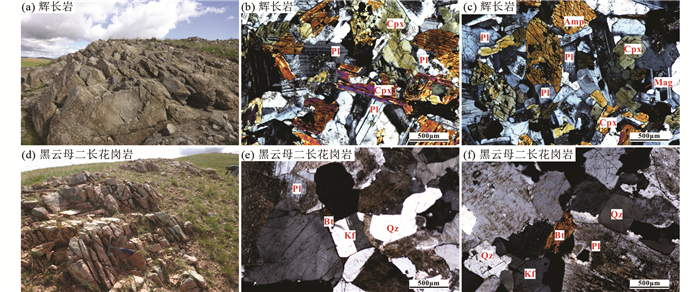
|
图 2 内蒙古中部西乌旗地区晚石炭世辉长岩-花岗岩系列野外和显微照片 Pl-斜长石; Kf-钾长石; Qz-石英; Bt-黑云母; Cpx-单斜辉石; Amp-角闪石; Mag-磁铁矿 Fig. 2 Representative field and thin-section photographs for the Late Carboniferous gabbro-granite from West Ujimqin of central Inner Mongolia Pl-plagioclase; Kf-K-feldspar; Qz-quartz; Bt-biotite; Cpx-clinopyroxene; Amp-amphibole; Mag-magnetite |
为岩株主体岩性的黑云母二长花岗岩呈现中细粒半自形粒状结构,块状构造(图 2d)。岩石风化面为黄褐色,新鲜面为粉红色。主要矿物组成包括斜长石、钾长石、石英和黑云母(图 2e, f)。斜长石呈半自形板状,发育聚片双晶,轻微绢云母化,粒径0.5~4mm,含量30%左右。钾长石呈半自形-他形结构,可见少量简单双晶,部分颗粒轻微高岭土化,粒径0.5~3mm,含量30%~35%。石英为他形粒状填充,晶面洁净,粒径0.3~2.5mm,含量30%~35%。黑云母呈半自形片状,具浅棕黄至棕褐多色性,少数有绿泥石化,粒径约0.5mm,含量5%左右。副矿物包括磷灰石、榍石和锆石。
3 分析方法 3.1 锆石SIMS U-Pb定年单矿物锆石挑选工作在河北省区域地质矿产调查研究所实验室完成。首先采用常规磁选和重液方法分选出锆石晶体,然后在双目镜下挑选晶体完整、包裹体少的大颗粒锆石,与标样锆石Plésovice(Sláma et al., 2008)和Qinghu(Li et al., 2013)一起贴到环氧树脂上抛光。上机测试前在光学显微镜下进行锆石的透射光和反射光分析,继而在中国科学院地质与地球物理研究所扫描电镜实验室采用德国LEO1450VP扫描电子显微镜(SEM)获取阴极发光(CL)图像。综合分析透反射及CL图像,观察锆石内部结构,选出最佳分析测试点,最后将样品镀金待测。
锆石SIMS U-Pb定年在中国科学院地质与地球物理研究所离子探针实验室CAMECA IMS-1280HR离子探针上完成,分析束斑为20×30μm,详细方法参照Li et al.(2009)。数据分析采用标准锆石Plésovice(337.1Ma)(Sláma et al., 2008)进行U-Th-Pb同位素比值的分馏校正,利用标准锆石Qinghu监测未知样品数据的精确度,最后采用Isoplot软件处理数据并计算年龄。测得7颗Qinghu锆石谐和年龄为160.0±1.8Ma,与推荐值159.5±0.2Ma在误差范围里一致(Li et al., 2013)。
3.2 全岩主量与微量元素分析通过岩相学检查,选择蚀变程度较小的新鲜样品在玛瑙研钵机中磨成小于200目的粉末,用于全岩地球化学分析,该过程同样在河北省区域地质矿产调查研究所实验室完成。
全岩主量元素分析在中国科学院地质与地球物理研究所岩矿制样与分析实验室完成。将样品与助溶剂(Li2B4O7+LiBO2)研磨混合均匀,用M-4燃气自动熔样机制取玻璃片后,采用顺序式X射线荧光光谱仪(AXIOS-Minerals、XRF-1500)测试。测试过程中选用国家标准物质GSR-1(花岗岩)和GSR-3(玄武岩)进行质量监控,对标准样品的分析结果表明,主量元素的分析精度为~1%(含量>10%)和~5%(含量<1.0%)。
全岩微量元素分析在中国地质大学(武汉)地质过程与矿产资源国家重点实验室完成。将样品用酸多步溶解配置样品溶液,然后使用Agilent 7500a型四极杆电感耦合等离子体质谱仪(ICP-MS)进行测试,具体分析流程参考Liu et al.(2008)。分析测定一套标准物质(AGV-2、BHVO-2、BCR-2、RGM-2),结果表明微量元素分析的精密度优于5%,准确度优于10%。
3.3 全岩Rb-Sr和Sm-Nd同位素测试全岩Rb-Sr和Sm-Nd同位素分析在中国科学院地质与地球物理研究所稳定同位素实验室完成,具体试验分析流程参见Li et al.(2015)。根据样品中微量元素Rb、Sr、Sm和Nd的含量,称取适量岩石粉末样品于前期清洗干净的Teflon溶样罐中,加入混合的87Rb-84Sr和149Sm-150Nd示踪剂,并酸(HF + HNO3 + HClO4)溶解后,采用经典的两阶段离子交换层析法分离样品中的Rb、Sr、Sm、Nd元素。同位素分析测试使用仪器为Finnigan MAT262型多接收热电离质谱仪(ID-TIMS)。利用88Sr/86Sr=8.375209和146Nd/144Nd=0.7219对同位素比值标准化,用于校正质量分馏。选用国际标样NBS-987和JNdi-1监控仪器在数据采集过程中的稳定性,使用BCR-2监控整个测试流程的准确度。
3.4 锆石原位Lu-Hf和O同位素分析锆石原位Lu-Hf同位素微区分析在中国科学院地质与地球物理研究所多接收等离子质谱实验室完成。选择在U-Pb年龄分析点上或者附近,利用脉冲速度为4Hz,直径为44μm的束斑进行分析,详细分析流程参见Wu et al.(2006)。测试仪器为配备了Geolas-193紫外激光剥蚀系统的Neptune多接收电感耦合等离子体质谱仪(LA-MC-ICPMS)。采用标准锆石SA01 (Huang et al., 2020)标样监测实验过程中的仪器稳定性,测得12颗SA01锆石176Hf/177Hf=0.282286±0.000013,与Hf同位素推荐值一致。
锆石氧同位素在中国科学院地质与地球物理研究所离子探针实验室CAMECA IMS-1280离子探针上完成。采用Cs+作离子源,测量的18O/16O比值用Vienna-标准大洋水(V-SMOW,18O/16O=0.0020052)进行标准化,测试标样为Penglai标准锆石(δ18O=5.31±0.10‰)(Li et al., 2010),并用Qinghu锆石作为未知标样,以确定仪器质量分馏的真实性。测得6颗Qinghu锆石的δ18O加权平均值为5.42±0.11‰,与推荐值5.4±0.2‰吻合(Li et al., 2013)。
4 分析结果 4.1 锆石U-Pb定年结果西乌旗猴头庙辉长岩和花岗岩的2个代表性样品(XW19-22-2和XW13-8-3)中锆石SIMS U-Pb分析结果见表 1。其中,辉长岩(XW19-22-2)中锆石为半自形柱状,长约50~130μm,长宽比为1∶1~3∶1。15颗锆石的分析结果显示,Th含量介于252×10-6~2006×10-6之间,U含量介于343×10-6~1378×10-6之间,0.73~1.48的Th/U值契合典型岩浆成因锆石区间(Williams, 1997)。所得206Pb/238U年龄值介于299.0~310.3Ma之间,所有分析点均落在一致曲线上,构成谐和年龄307.1±2.1Ma(MSWD=4.9)(图 3a),代表辉长岩的结晶年龄。
|
|
表 1 内蒙古中部西乌旗地区晚石炭世辉长岩-花岗岩系列锆石U-Pb年龄 Table 1 SIMS zircon U-Pb analyses for the Late Carboniferous gabbro-granite from West Ujimqin of central Inner Mongolia |

|
图 3 内蒙古中部西乌旗地区晚石炭世辉长岩-花岗岩系列锆石阴极发光图像和U-Pb年龄谐和图 Fig. 3 Representative cathodoluminescence(CL)images of the dated zircons and zircon U-Pb concordia diagrams for the Late Carboniferous gabbro-granite from West Ujimqin of central Inner Mongolia |
花岗岩(XW13-8-3)中锆石呈自形到半自形等轴粒状或短柱状,长约30~150μm,长宽比为1∶1~2.5∶1。阴极发光图像显示锆石具有清晰的岩浆成因同心震荡环带(图 3b)。15颗无裂隙损伤锆石的U-Pb分析结果显示,其中3颗(点03、16、17)锆石年龄异常,可能与高Th、U含量或较大误差值有关。其余锆石Th、U含量变化较小,Th为151×10-6~678×10-6,U为130×10-6~970×10-6,Th/U值为0.70~1.51。206Pb/238U年龄值介于289.8~314.1Ma之间,12颗锆石分析点均落在谐和线上,形成谐和年龄为304.9±3.5Ma(MSWD=0.37)(图 3b),代表花岗岩岩体的结晶年龄。
4.2 元素地球化学特征内蒙古中部西乌旗地区晚石炭世铁镁质-长英质侵入岩套的全岩主-微量元素分析结果列于表 2。根据Na2O + K2O-SiO2分类图(Le Maitre et al., 1989),基性岩主要分布在辉长岩至辉长闪长岩区间,而长英质侵入岩均落入花岗岩类(图 4a)。
|
|
表 2 内蒙古中部西乌旗地区晚石炭世辉长岩-花岗岩系列主量(wt%)和微量(×10-6)元素地球化学成分 Table 2 Major(wt%) and trace(×10-6)element compositions for the Late Carboniferous gabbro-granite from West Ujimqin of central Inner Mongolia |
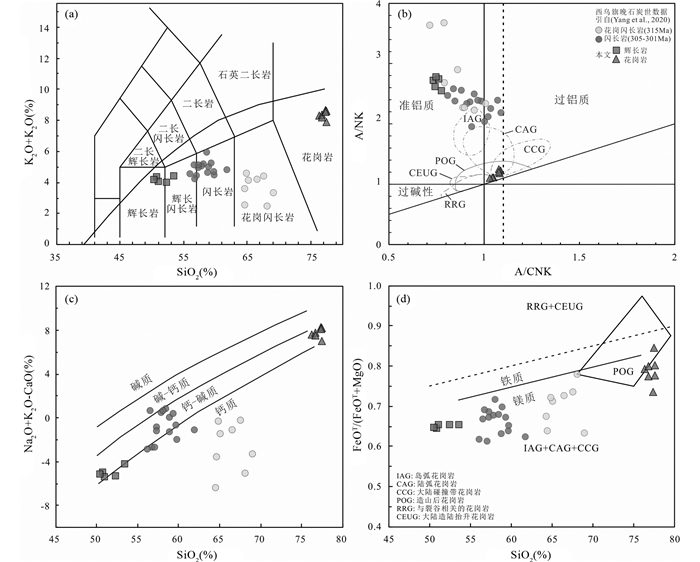
|
图 4 内蒙古中部西乌旗地区晚石炭世辉长岩-花岗岩系列分类图 (a)(Na2O+ K2O)-SiO2分类图(Le Maitre et al., 1989); (b)A/NK-A/CNK图(A/NK=摩尔Al2O3/(Na2O+K2O); A/CNK=摩尔Al2O3/(CaO + Na2O + K2O))(Maniar and Piccoli, 1989); (c)(Na2O+K2O-CaO)-SiO2图(Frost et al., 2001); (d)FeOT/(FeOT+MgO)-SiO2图(Frost et al., 2001) Fig. 4 Classification diagrams for the Late Carboniferous gabbro-granite from West Ujimqin of central Inner Mongolia |
辉长岩样品的SiO2含量变化于50.4%~53.4%之间,TiO2含量为1.08%~1.16%;具有较高的Fe2O3T(9.10%~10.4%)、Al2O3(17.2%~17.8%)和CaO(8.60%~9.48%);中等的MgO(4.33%~ 4.99%)和全碱(Na2O + K2O = 4.06%~4.47%);低P2O5(0.11%~0.12%)。铝饱和指数ASI(A/CNK=摩尔Al2O3 /(CaO+Na2O+K2O))介于0.73~0.78之间,Mg#(=摩尔MgO/(MgO+FeO))介于52~54之间。根据Frost et al.(2001)分类指标,辉长岩呈现镁质、准铝质和钙碱-钙质(图 4b-d)特征。在微量元素方面,辉长岩具有比较平缓的稀土元素配分模式(图 5a),(La/Yb)N为1.81~ 4.17,δEu值为0.69~1.11;在原始地幔标准化微量元素蛛网图上(图 5b),辉长岩富集Rb、Th、U、Pb等大离子亲石元素(LILEs),亏损Nb、Ta等高场强元素(HFSEs)。

|
图 5 内蒙古中部西乌旗地区晚石炭世辉长岩-花岗岩系列球粒陨石标准化稀土元素配分曲线(a)和原始地幔标准化微量元素蛛网图(b)(标准化值据Sun and McDonough, 1989) Fig. 5 Chondrite-normalized REE pattern (a) and PM-normalized trace element spiderdiagram (b) for the Late Carboniferous gabbro-granite from West Ujimqin of central Inner Mongolia(normalization values from Sun and McDonough, 1989) |
花岗岩样品SiO2含量变化于76.3%~77.6%,高Na2O(2.48%~3.98%)和K2O(4.90%~6.17%)(图 4a),中等的Al2O3(12.0%~13.5%),贫Fe2O3T(0.46%~0.75%)、MgO(0.09%~0.17%)、CaO(0.41%~0.89%)、TiO2(0.08%~0.10%)和P2O5(0.01%~0.03%)。岩石呈弱过铝质特征,铝饱和指数ASI为1.03~1.09(图 4b)、钙碱性(图 4c)和镁-铁质(图 4d)。花岗岩稀土元素含量相对较低(ΣREE=62.8×10-6~106×10-6),球粒陨石标准化稀土元素配分图显示弱右倾型模式((La/Yb)N=3.61~8.50)(图 5a),大部分样品明显具有负Eu异常,δEu介于0.29~0.94之间;在原始地幔标准化微量元素蛛网图上(图 5b),花岗岩富集Rb、Th、U、Pb等元素,而亏损Ba、Nb、Ta、Sr、P等元素。
4.3 全岩Sr-Nd同位素特征代表性辉长岩和花岗岩样品的Rb-Sr和Sm-Nd同位素分析结果和根据锆石U-Pb年龄计算的相应初始比值见表 3。辉长岩初始Sr同位素比值(87Sr/86Sr)t(可用ISr(t)表示)为0.704249~0.704330(图 6a),Nd同位素初始比值(143Nd/144Nd)t为0.512331~0.512438,εNd(t)值介于+1.73~+3.81之间(图 6a, b),Nd同位素单阶段模式年龄tNdDM1变化于890~909Ma。介于-0.60~+0.20之间的fSm/Nd值(-0.41~-0.29)指示该模式年龄地质意义有效(Jahn et al., 2000)。
|
|
表 3 内蒙古中部西乌旗地区晚石炭世辉长岩-花岗岩系列全岩Rb-Sr和Sm-Nd同位素分析数据 Table 3 Whole rock Rb-Sr and Sm-Nd isotopic data for the Late Carboniferous gabbro-granite from West Ujimqin of central Inner Mongolia |
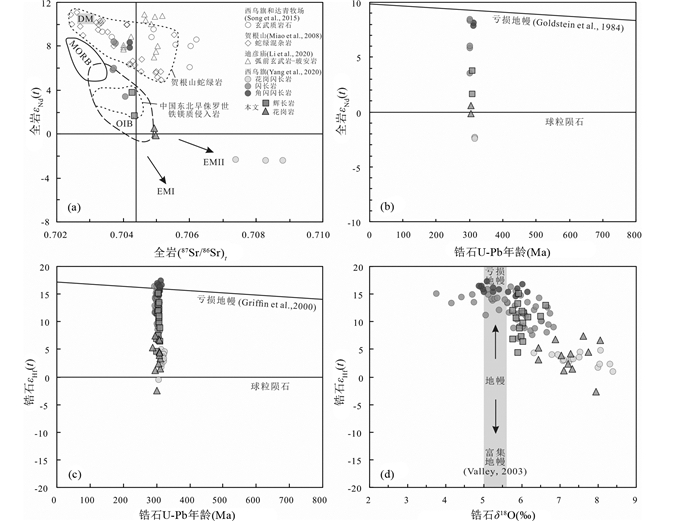
|
图 6 内蒙古中部西乌旗地区晚石炭世辉长岩-花岗岩系列同位素地球化学图解 (a)全岩εNd(t)-(87Sr/86Sr)t图; (b)全岩εNd(t)-锆石U-Pb年龄图; (c)锆石εHf(t)-U-Pb年龄图; (d)锆石εHf(t)-δ18O图. 图(a)中中国东北早侏罗世铁镁质侵入岩来源于Yu et al.(2012)和Feng et al.(2021),石炭纪贺根山蛇绿岩范围来源于Miao et al.(2008) Fig. 6 Isotopic plots for the Late Carboniferous gabbro-granite from West Ujimqin of central Inner Mongolia (a)plot of whole-rock εNd(t) vs.(87Sr/86Sr)t; (b)plot of whole-rock εNd(t) vs. zircon U-Pb age; (c)plot of zircon εHf(t) vs. U-Pb age; (d)plot of zircon εHf(t) vs. δ18O. In Fig. 6a, the field for Early Jurassic mafic intrusive rock from NE China from Yu et al.(2012)and Feng et al.(2021). The field for Carboniferous Hegenshan ophiolite from Miao et al.(2008) |
花岗岩ISr(t)介于0.704923~0.704981之间(图 6a),(143Nd/144Nd)t为0.512238~0.512274,εNd(t)值为-0.15~+0.57(图 6a, b);Nd同位素两阶段模式年龄tNdDM2介于1019~1077Ma之间。
4.4 锆石Hf-O同位素特征表 4列出了2个辉长岩和花岗岩测年样品(XW19-22-2和XW13-8-3)的锆石原位Hf和O同位素分析结果以及依据各自年龄计算的Hf同位素初始值。其中,辉长岩中锆石初始Hf同位素(176Hf/177Hf)t比值变化范围为0.282714~0.283011,εHf(t)值介于+4.58~+15.16之间(图 6c),Hf亏损地幔模式年龄tDMHf为336~768Ma。锆石δ18O介于5.75‰~6.61‰之间(图 6d),略高于正常地幔δ18O值(δ18O=5.3±0.6‰)(Valley et al., 1998)。
|
|
表 4 内蒙古中部西乌旗地区晚石炭世辉长岩-花岗岩系列锆石Lu-Hf和O同位素分析数据 Table 4 In-situ zircon Lu-Hf and O isotopic data for the Late Carboniferous gabbro-granite from West Ujimqin of central Inner Mongolia |
花岗岩样品(XW13-8-3)中12颗谐和锆石的(176Hf/177Hf)t变化于0.282510~0.282796,εHf(t)介于-2.63~+7.40之间(图 6c),锆石Hf地壳模式年龄tDMC变化于832~1483Ma。锆石δ18O介于6.44‰~8.06‰之间(图 6d)。
5 讨论 5.1 辉长岩成因猴头庙辉长岩新鲜的产出状态和较低的烧失量(0.70%~1.18%)指示,其全岩地球化学成分基本未受岩浆期后地质作用影响,因此可以有效示踪其岩石成因。首先,猴头庙辉长岩低硅(SiO2=50.4%~53.4%)、高Fe2O3T(9.10%~10.4%)和MgO(4.33%~4.99%)的主量元素特征明显不同于任何壳源物质(Rudnick and Gao, 2003)或壳源熔体(Patiño Douce, 1997),表明其母岩浆来源于地幔部分熔融。其次,猴头庙辉长岩的MgO、Cr和Ni含量明显低于典型堆晶成因辉长岩(MgO>15%、Cr>2000×10-6、Ni>300×10-6)(Roberts et al., 2000),结合其岩墙式产状和中细粒半自形粒状结构,说明其并非岩浆堆晶过程的产物。
与可能代表本区晚石炭世原始幔源玄武质岩浆(Liu et al., 2013;Zhou et al., 2016; 庞崇进等,2018)相比,MgO、Cr和Ni等含量较低的猴头庙辉长岩经历了不同程度的分离结晶作用。如哈克图解所示(图 7a-c),主量元素与SiO2明显的线性相关关系表明岩浆源区存在橄榄石和单斜辉石结晶分异;Co、Cr和Ni与MgO的正相关关系(图 7d-f)指示岩浆侵位过程中橄榄石、辉石、角闪石、铬铁矿等铁-钛氧化物结晶分异;而弱Eu异常暗示斜长石的结晶分异较弱。
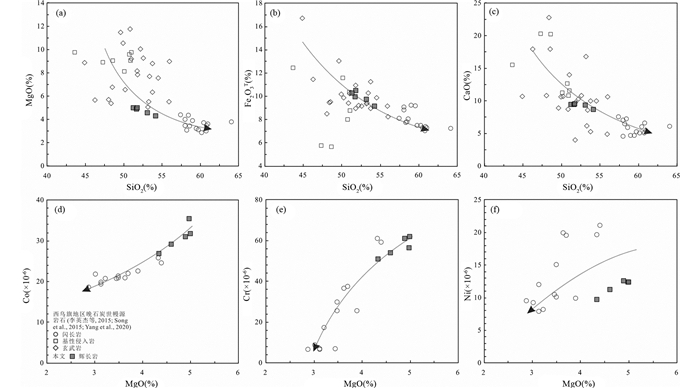
|
图 7 内蒙古中部西乌旗地区晚石炭世辉长岩的代表性元素变化图 Fig. 7 Representative element variation diagrams for the Late Carboniferous gabbro from West Ujimqin of central Inner Mongolia |
猴头庙辉长岩不同程度地富集大离子亲石元素和轻稀土元素,亏损高场强元素,故而呈现较高的La/Nb(1.39~3.84)、Zr/Nb(3.77~41.7)和较低的Ce/Pb(1.94~9.07)。这种典型岛弧玄武岩的微量元素特征一般归因于交代岩石圈地幔的部分熔融或MORB型岩浆在侵位过程中经历地壳混染作用。猴头庙辉长岩的以下特征表明其在形成过程中没有经历明显的地壳混染:(1)其总体上低硅富铁镁并具相对均一的锆石Hf-O同位素组成;(2)其锆石年龄单一而无捕获锆石;(3)其呈现U富集和Nb-Ta-Ti亏损的耦合变化(图 5b),而经历地壳混染的幔源岩浆通常没有这种规律性变化(Zhou et al., 2004);(4)样品中Zr、Hf均未出现明显的正异常,这与大陆地壳中Zr、Hf相对富集不一致;(5)样品具有较高的Ti/Y(168~392)、Nb/Th(0.48~1.98)和较低的Th/Yb(0.92~3.15)比值,与上地壳物质明显的贡献不吻合(Zhao and Zhou, 2007);(6)两个硅镁值类似样品的全岩Nd同位素组成差别较大。
因此,猴头庙辉长岩岛弧玄武岩型的元素地球化学特征反映了其经历交代的不均一地幔源区。这种交代地幔性质具体取决于参与俯冲板片的物质组成(蚀变洋壳或沉积物)与传输机制(流体或熔体),不同交代介质倾向于在交代地幔中产生独特的元素和同位素印记。板片流体通常携带大量Si、LILE改变浅部地幔楔成分(Plank and Langmuir, 1993; Stein et al., 1997),而熔体交代一般发生在地幔楔深部区域(Kilian and Stern, 2002),形成富钠交代产物。流体-熔体交代会导致微量元素对如Ba/La、Th/La、Pb/La及Nb/Y等的规律性变化(Pearce et al., 1999; Plank, 2005),因此这些元素对可以很好的区分俯冲沉积物、流体-熔体对地幔源区的改造(Woodhead et al., 2001; Turner et al., 2012)。猴头庙辉长岩的高Ba/La和低Th/Y值(0.09~0.32)反映俯冲沉积物的输入有限(图 8a),而其低Nb/Y(0.14~0.34)和La/Yb(2.52~5.82)以及高U/Nb(0.16~0.74)和Pb/Ce(0.11~0.52)均指示俯冲板片流体的重要贡献(图 8b, c)。
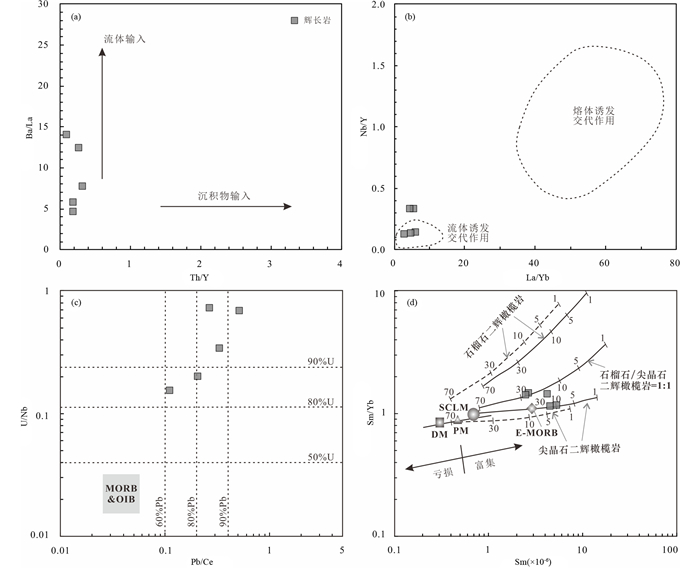
|
图 8 内蒙古中部西乌旗地区晚石炭世辉长岩成因判别图 (a)Ba/La-Th/Y图,反映不同来源的富集贡献矢量来源于Woodhead et al.(2001); (b)Nb/Y-La/Yb图,参考区域来源于Hoffer et al.(2008); (c)U/Nb-Pb/Ce图,参考区域来源于Regelous et al.(2014); (d)Sm/Yb-Sm图,不同初始物质计算的熔体曲线根据Shaw(1970),虚线和实线分别为亏损地幔和富集大陆岩石圈地幔的熔融趋势 Fig. 8 Petrogenesis discrimination plots for the Late Carboniferous gabbro from West Ujimqin of central Inner Mongolia (a)plot of Ba/La vs. Th/Y, the vectors reflect different enrichment contributions in the source as discussed from Woodhead et al.(2001); (b)plot of Nb/Y vs. La/Yb, the reference fields from Hoffer et al.(2008); (c)plot of U/Nb vs. Pb/Ce, the reference fields from Regelous et al.(2014); (d)plot of Sm/Yb vs. Sm, the melt curves were calculated with different starting materials from Shaw(1970), the dashed and solid lines are the melting trends for depleted mantle and enriched subcontinental lithospheric mantle, respectively |
俯冲流体为主的交代介质也与猴头庙辉长岩略高于地幔值的锆石δ18O(5.75‰~6.61‰)相契合,正如同样记录了高δ18O流体加入的美国加州早白垩世Sierra Nevada岩基中辉长岩(Lackey et al., 2005)。此外,猴头庙辉长岩普遍呈现的新元古代Nd-Hf模式年龄暗示其交代岩石圈地幔源区可能形成于新元古代-早古生代,这既与兴蒙造山带地幔岩包体Os同位素显示的岩石圈地幔形成年龄相一致(Zhang et al., 2000, 2012),也符合内蒙古中部早古生代经历洋壳俯冲的活动大陆边缘背景(Yuan et al., 2022)。
实验岩石学表明方辉橄榄岩部分熔融通常形成富镁玄武质熔体,二辉橄榄岩部分熔融可以形成低镁高铝的玄武质岩浆(Hirose and Kushiro, 1998; Yang et al., 2016),而熔体稀土元素模式主要受制于岩浆源区中石榴石和尖晶石含量。猴头庙辉长岩低镁高铝的主量元素特征契合二辉橄榄岩部分熔融的产物,而其低(Tb/Yb)N(0.93~1.31)符合尖晶石相平衡熔体;猴头庙辉长岩在Sm/Yb-Sm图(Shaw, 1970)中落入靠近尖晶石相二辉橄榄岩部分熔融曲线附近(图 8d),指示其原始岩浆主要来自尖晶石相二辉橄榄岩的部分熔融。
综上所述,猴头庙辉长岩来源于俯冲板片流体交代亏损岩石圈地幔楔的部分熔融,并在上升过程中经历了一定程度的结晶分异。
5.2 花岗岩成因猴头庙黑云母二长花岗岩高硅、富碱以及镁铁质(FeOT/MgO=2.76~5.40)过渡特征符合高硅花岗岩之涵义(Lee and Morton, 2015),其低Sr、Eu含量和高Rb/Sr比也与美国南加州半岛岭岩基中典型高硅花岗岩相似(Lee and Morton, 2015)。鉴于这种高硅花岗岩的高分异成因特质,其原始岩浆属性和岩石成因需要综合多方面证据加以约束,尤其需要参考同时代共生偏镁铁质岩石的岩石类型(吴福元等, 2017)。
一方面,猴头庙二长花岗岩虽属过铝质但铝饱和指数小于1.1,P2O5(0.01%~0.03%)含量很低,同时在P2O5和SiO2相关图上与同区晚石炭世花岗闪长岩构成明显的负相关关系,契合磷灰石饱和规则且与高分异Ⅰ型花岗岩演化趋势(Clemens et al., 2011),也与Rb-Th图所示中典型Ⅰ型花岗岩演化趋势相一致(Chappell, 1999)(图 9c)。
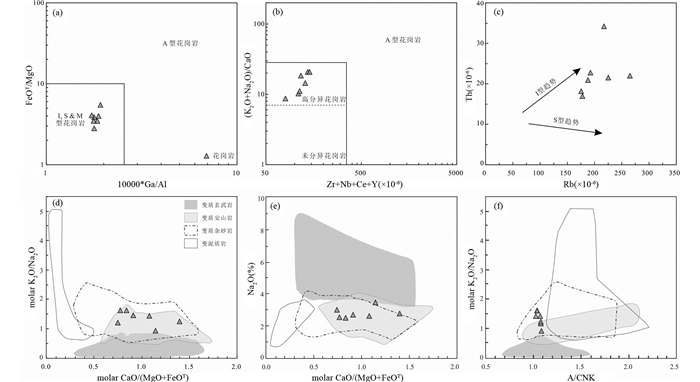
|
图 9 内蒙古中部西乌旗地区晚石炭世花岗岩的元素地球化学属性(a-c)和样品成分与各类源岩部分熔融实验结果对比(d-f) (a)FeOT/MgO-10000×Ga/Al判别图(Whalen et al., 1987); (b)(K2O+Na2O)/ CaO-(Zr+Nb+Ce+Y)判别图(Whalen et al., 1987); (c)Th-Pb趋势图(Chappell, 1999); (d)摩尔K2O/Na2O-摩尔CaO/(MgO+FeOT)图; (e)Na2O-摩尔CaO /(MgO+FeOT)图; (f)摩尔K2O/Na2O-A/CNK图(图d-f据Altherr and Siebel, 2002修改) Fig. 9 The elemental affinity(a-c) and comparison between the composition of samples and the compositional fields of experimental melts derived from dehydration melting of various bulk compositions(d-f)for the Late Carboniferous granite from West Ujimqin of central Inner Mongolia (a)FeOT/MgO vs. 10000×Ga/Al discrimination diagram(Whalen et al., 1987); (b)(K2O+Na2O)/ CaO vs.(Zr+Nb+Ce+Y)discrimination diagram(Whalen et al., 1987); (c)plot of Th vs. Pb(Chappell, 1999); (d)plot of molar K2O/Na2O vs. molar CaO/(MgO+FeOT); (e)plot of Na2O(%)vs. molar CaO/(MgO+FeOT); (f)plot of molar K2O/Na2O vs. A/CNK(d-f, modified after Altherr and Siebel, 2002) |
另一方面,猴头庙花岗岩的Ga/Al<2.1,Zr+Nb+Ce+Y<250×10-6,FeOT/MgO<6,这些均与经典A型花岗岩特征值相悖,而契合高分异Ⅰ型花岗岩范畴(图 9a, b)。虽然强分异A型花岗岩也可能落入高分异花岗岩区域(King et al., 2001),但二者在结晶温度等方面仍存在显著差异(吴福元等, 2017)。猴头庙花岗岩介于718~770℃之间的锆饱和温度(Watson and Harrison, 1983)和介于673~716℃之间的全岩Al-Ti温度(Jung and Pfänder, 2007)可以佐证其Ⅰ-型花岗岩的低温内涵。
基于组成矿物元素相容性制约的全岩元素成分变化,可以刻画岩浆的基本结晶分异过程。在哈克图解中,主量元素与SiO2呈明显的线性关系(图 10),可能与岩浆上升和侵位过程中辉石、角闪石、磷灰石和铁钛氧化物等结晶分异有关。猴头庙花岗岩总体呈现低K/Rb(193~249),高Ca/Sr(48~137),中等负Eu、Ba和Sr异常;这些元素变化主要受控于斜长石和钾长石分离结晶,其中斜长石分异引起Sr、Eu负异常,钾长石分异造成Ba、Eu负异常(Wu et al., 2003)。显著的P负异常可能与磷灰石分离结晶有关,Ti负异常可能归因于金红石或钛铁矿等矿物分离结晶。此外,偏低的稀土元素总量(ΣREE=62.8×10-6~106×10-6)和轻重稀土比((La/Yb)N=3.61~8.50)可能与富含稀土元素的独居石或帘石族矿物的分离有关;低于花岗岩体系岩浆-热液分界(Zr/Hf=26)(Bau, 1996)的全岩Zr/Hf比(18~24)既暗示锆石的分离结晶(Pérez-Soba and Villaseca, 2010),也指示岩浆演化后期流体作用的影响(Bau, 1996);类似地,低于上地壳(Nb/Ta=13.4)(Rudnick and Gao, 2003)的全岩Nb/Ta值(平均值为8.0)可能反映黑云母分离结晶与岩浆-热液作用的双重影响(Stepanov et al., 2014; Ballouard et al., 2016)。
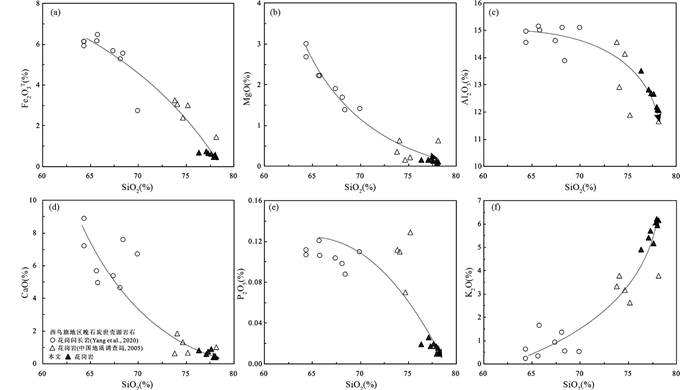
|
图 10 内蒙古中部西乌旗地区晚石炭世花岗岩的代表性元素变化图 Fig. 10 Representative element variation diagrams for the Late Carboniferous granite from West Ujimqin of central Inner Mongolia |
虽然全球大量典型Ⅰ型花岗岩研究案例将其初始母岩浆诉诸于:(1)中基性浆源岩石部分熔融(Roberts and Clemens, 1993; Sisson et al., 2005)、(2)经历强烈分异与同化过程的幔源玄武质岩浆(Moghazi, 2003; Kaur et al., 2009)、或(3)壳-幔岩浆的混合产物(Clemens et al., 2009; Karsli et al., 2010),但实验和数值模拟确证基性岩浆同化过程因能量障碍而难以实现(Glazner, 2007;Whitaker et al., 2008)。Ⅰ型花岗岩的浆源地壳物质深熔论已成当前共识(吴福元等, 2007; 王孝磊, 2017),而中性浆源岩石是熔出钙碱性Ⅰ型花岗岩的最适宜源岩(Clemens et al., 2011),这得到大量实验岩石学研究结果充分支持(Beard and Lofgren, 1991; Skjerlie and Johnston, 1993; Patiño Douce, 1997; Patiño Douce and McCarthy, 1998; Altherr and Siebel, 2002)。
猴头庙花岗岩虽然属于分异型高硅花岗岩,但其弱过铝质和钙碱性属性说明其经历的结晶分异程度不高,且结晶分异作用主要受控于对主量元素影响不大的副矿物。因此,其主量元素成分与变安山质岩石中低压条件下部分熔融生成的长英质熔体具有很好的相容性(图 9d-f),可以有效指示其源区性质。
相对于源区信息有所削弱的元素地球化学特征,高保真同位素组成是示踪花岗岩源区属性的可靠指标。猴头庙花岗岩中等放射成因的全岩εNd(t)(-0.15~+0.57)和锆石εHf(t)(-2.63~+7.40)、中元古代Nd-Hf地壳模式年龄、以及明显高于正常地幔的锆石δ18O值(6.44‰~8.06‰),均与同区毗邻的稍早侵位的花岗闪长岩相当(Yang et al., 2020),反映中新元古代古大陆边缘建造期成熟地壳物质的存在。这不仅契合内蒙古中部中新元古代经历的罗迪尼亚超大陆活动大陆边缘增生历史(Zhou et al., 2018; 孙立新等,2020),而且与全球典型古汇聚大陆边缘中基性下地壳普遍高δ18O的趋势相一致(Peck and Valley, 2000; Lackey et al., 2005)。由于锆石中氧的低扩散速率及高封闭温度,后期变质作用与热液蚀变很难改变锆石氧同位素组成而得以保留其初始信息(Cherniak and Watson, 2003),古活动大陆边缘中下地壳岩石的锆石高氧同位素组成通常指示高δ18O流体或含水硅酸盐熔体的加入(King et al., 1998; Lackey et al., 2005)。
综合猴头庙花岗岩的源区属性和分异特征,我们推测:由于同时期幔源岩浆底侵事件提供的必要热源,内蒙古中部由中元古代和古生代多期增生物质组成的复合中基性地壳发生部分熔融,析出具中等放射成因εNd(t)和εHf(t)以及中元古代模式年龄的高钾钙碱性Ⅰ型酸性岩浆,其进一步结晶分异形成猴头庙花岗岩。
5.3 地球动力学意义本次高精度锆石U-Pb定年确定西乌旗猴头庙辉长岩-花岗岩系列于晚石炭世(约305Ma)侵位。其时代不仅与西乌旗地区钙碱性辉绿岩岩墙群相近(Zhu et al., 2017),而且与区域上的类似双峰式岩浆建造近于同步,例如二连浩特地区约305Ma的A型花岗岩和富闪深成岩系列(Yuan et al., 2022)、南蒙古地体约306Ma高钾钙碱性辉绿岩-花岗岩系列(Hu et al., 2017)。这些岩浆岩建造表明晚石炭世末期中亚造山带东段处于弥散状的伸展背景。
一方面,这种双峰式侵入岩建造通常出现在内蒙古中部石炭纪幕式岩浆活动的最晚期阶段(Yang et al., 2020; Yuan et al., 2022)。石炭纪岩浆幕从早石炭世的零星记录(李梦瞳等, 2020)发展到沿二连浩特-贺根山-西乌旗蛇绿混杂岩带两侧地体分布的钙碱性-高钾钙碱性岩浆岩带,岩性上涵盖辉长岩-闪长岩-花岗岩整个系列的侵入杂岩和成分相当的火山岩系列(Fu et al., 2016; Zhou et al., 2016; Li et al., 2017, 2021; Yang et al., 2020; Liu et al., 2021; Yuan et al., 2022)。它们在时间上与同区蛇绿混杂岩基本同步(Miao et al., 2008; Song et al., 2015; Zhang et al., 2015b; Li et al., 2018, 2020),在岩石地球化学特征上与世界典型活动大陆边缘建造基本一致(Ducea et al., 2015)。
另一方面,晚石炭世末期伸展型岩浆建造迥异于分布广瀚的早二叠世火成岩省。后者包括290~280Ma苏左旗-东乌旗碱性-过碱性花岗岩带(Cheng et al., 2014;Zhang et al., 2015a)和二连浩特-锡林浩特-西乌旗285~276Ma碱长花岗岩-正长花岗岩系列(Tong et al., 2015; Yuan et al., 2016)、以约280Ma大石寨组火山岩为代表的双峰式火山岩(Zhang et al., 2008, 2011)、以及由辉长岩/辉绿岩和A型花岗岩组成的双峰式侵入岩(程银行等, 2016; Zhang et al., 2021b, c)。它们不仅是东北早二叠世碱性岩带的重要组成部分(Wu et al., 2002;Jahn et al., 2009;Litvinovsky et al., 2015),而且其以碱性花岗岩和双峰式岩浆岩主导的建造特征等效于典型后碰撞岩浆岩建造(Bonin, 2004)。
作为内蒙古中部及邻区最重要的岩浆爆发幕,石炭纪至早二叠世岩浆活动的地球动力学背景是揭示古亚洲洋闭合轨迹的关键窗口。虽然大部分学者遵循“多岛洋俯冲-增生”范式将其归于弧后盆地裂解-伸展、洋脊俯冲、陆-弧碰撞、碰撞后伸展等安第斯弧型活动大陆边缘周期性伸展过程(Xiao et al., 2003, 2018; Zhang et al., 2008, 2011, 2021b; Eizenhöfer et al., 2014; Song et al., 2015; Yuan et al., 2016, 2022; Eizenhöfer and Zhao, 2018; Jiang and Zhu, 2020; Yang et al., 2020),但仍有一部分学者坚持其是内蒙古板内造山带多期裂谷活动的产物(邵济安等, 2015; Wang et al., 2016; Zhu et al., 2017; 庞崇进等, 2018; 徐备等, 2018)。由于大洋板块俯冲期和造山后伸展期继承性的深部流体循环以及相似的地幔源区流体交代作用(Wang et al., 2016),因此仅基于幔源玄武质岩浆微量元素地球化学行为示踪地球动力学背景力有不逮。多学科证据的综合约束显然是重现古亚洲洋闭合阶段地球动力学演化场景的唯一途径。
在贺根山-西乌旗地区,年龄介于361~305Ma之间的系列蛇绿混杂岩(Miao et al., 2008; 李英杰等, 2013, 2015; Song et al., 2015; Li et al., 2018, 2020)记录了类似西太平洋IBM岛弧从弧前裂解到弧后扩张的完整演化序列(Ishizuka et al., 2014);一系列中酸性侵入岩在Whalen and Hildebrand(2019)最近提出的、适用于SiO2介于55%~70%之间的岩浆岩的相关构造环境判别图上均落入岛弧区(图 11a-d),表征了一个向北(现今坐标)俯冲工场形成的石炭纪岛弧和弧后盆地体系(Yang et al., 2020);晚石炭世-早二叠世火山沉积建造记录了典型弧后盆地的碎屑锆石年龄谱(Eizenhöfer et al., 2015)。
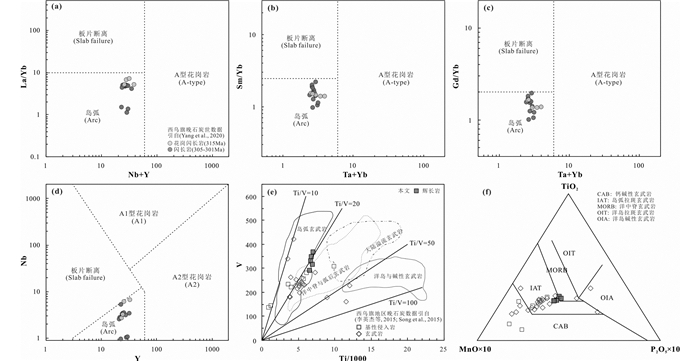
|
图 11 内蒙古中部西乌旗地区晚石炭世辉长岩和中酸性侵入岩的构造环境判别图解 (a)La/Yb-Nb+Y判别图; (b)Sm/Yb-Ta+Yb判别图; (c)Gd/Yb-Ta+Yb判别图; (d)Nb-Y判别图(a-d,据Whalen and Hildebrand, 2019修改); (e)V-Ti/1000判别图(Shervais, 1982); (f)TiO2-MnO×10-P2O5×10判别图(Mullen, 1983) Fig. 11 Tectonic discrimination plots for the Late Carboniferous gabbro and intermediate-felsic intrusions from West Ujimqin of central Inner Mongolia (a)La/Yb vs. Nb+Y discrimination diagram; (b)Sm/Yb vs. Ta+Yb discrimination diagram; (c)Gd/Yb vs. Ta+Yb discrimination diagram; (d) Nb vs. Y discrimination diagram(a-d, modified after Whalen and Hildebrand, 2019); (e)V vs. Ti/1000 discrimination diagram(Shervais, 1982); (f)TiO2-MnO×10-P2O5×10 discrimination diagram(Mullen, 1983) |
在区域地质演化方面,内蒙古中部晚古生代岩浆旋回以零星出露的晚泥盆世钙碱性岩浆岩建造为启动标志,历经早-中石炭世高钾钙碱性岩浆幕,终结于晚石炭世-早二叠世类型庞杂的大规模岩浆活动,这些岩浆岩序列见证了活动大陆边缘从俯冲重启、经板片回卷与弧后扩张、至脊-沟碰撞与弧后盆地闭合的完整演化旋回(Li et al., 2021; Yuan et al., 2022);索伦山-西拉木伦一线多处早二叠世放射虫遗存指示其时存在的古亚洲洋残余洋盆(尚庆华, 2004; 李钢柱等, 2017);内蒙古中部晚石炭世-早二叠世火山沉积地层的最新古地磁学证据表明其时洋盆南北之宽尚达2700km(Zhang et al., 2021a)。这些地区和区域性地质事实表明,内蒙古中部石炭纪至早二叠世仍然处于威尔逊造山旋回的洋-陆俯冲阶段。
如引言所述,典型活动大陆边缘建造期间存在弧后盆地裂解、板片回退、洋脊俯冲、板片断离等一系列可引起岩石圈伸展的地球动力学场景,其中残余洋脊俯冲是大洋板块动力学系统的终极环节(Sisson et al., 2003; Windley and Xiao, 2018; Wang et al., 2020)。环太平洋活动大陆边缘陆续厘定的典型洋脊俯冲案例表明(Sisson et al., 2003),不同地区洋脊俯冲相关板片窗效应虽然各具特征,但呈现一系列明显有别于大洋板块正常俯冲阶段的标志性岩浆、变质、沉积与构造印记:包括拉斑玄武岩、富铌玄武岩、高镁安山岩、埃达克岩、双峰式火山岩、基性岩墙群、I-A复合型花岗岩等的复杂岩浆建造组合;高温低压与低温低压条件共存的双重区域变质带;上覆板块拉张形成一系列弧前和弧后盆地;区域整体快速抬升与走滑断裂制约的前弧盆地;包括远洋沉积物和蛇绿混杂岩的前弧增生楔。
就岩浆组合而言,内蒙古中部及邻区晚石炭世末期不乏诸如新生代北美科迪勒拉(Thorkelson and Taylor, 1989; Cole and Stewart, 2009; Thorkelson et al., 2011)、上新世智利南部(Lagabrielle et al., 1994)和中亚造山带晚石炭世准噶尔(Geng et al., 2009; Tang et al., 2010, 2012; Windley and Xiao, 2018)等与洋脊俯冲-板片窗相关的典型岩浆组合。例如,拉斑玄武岩(Liu et al., 2013;Zhu et al., 2017)、高镁安山或玻安质岩石(Yang et al., 2020;Yuan et al., 2022)、埃达克岩(Wei et al., 2017; Li et al., 2021)、A型花岗岩(Li et al., 2021; Yuan et al., 2022)、Ⅰ型花岗岩(Hu et al., 2017; Li et al., 2021)和基性岩墙群(Hu et al., 2017)。
因此,结合内蒙古中部基底变质杂岩及伴生石炭纪基性岩普遍记录的320~305Ma高温低压变质作用(Zhang et al., 2018;庞崇进等,2018),作者认为西乌旗地区晚石炭世末期正在经历洋脊俯冲过程,猴头庙辉长岩-花岗岩系列是这一突变构造事件的典型响应(图 12)。一方面,板片窗因洋脊俯冲而开启,软流圈沿其上涌并在俯冲带形成伸展型热点环境,板片窗上覆岩石圈地幔因高度部分熔融而形成拉斑玄武岩(Liu et al., 2013; Zhu et al., 2017),亏损再富集地幔多次熔融产生玻安质岩石(Yang et al., 2020),板片熔体交代地幔楔低度熔融形成高镁闪长岩(Yuan et al., 2022),以及板片脱水流体交代地幔楔部分熔融形成呈现火山弧和洋中脊玄武岩双重地球化学属性的辉长岩(图 11e, f)。另一方面,板片窗热岛效应引发大规模的地壳熔融现场,其中板片窗两侧年轻热洋壳部分熔融形成埃达克岩(Wei et al., 2017; Li et al., 2021);中-新元古代遗存地壳和古生代新增生中基性物质组成的复合地壳因脱水熔融而析出同位素组成各异的原始Ⅰ型酸性岩浆,其后经历分离结晶遂成高分异Ⅰ型花岗岩(Hu et al., 2017; 本文);而经脱水富含碱性长石的紫苏花岗质岩石高温部分熔融生成A型花岗岩(Yuan et al., 2022)。
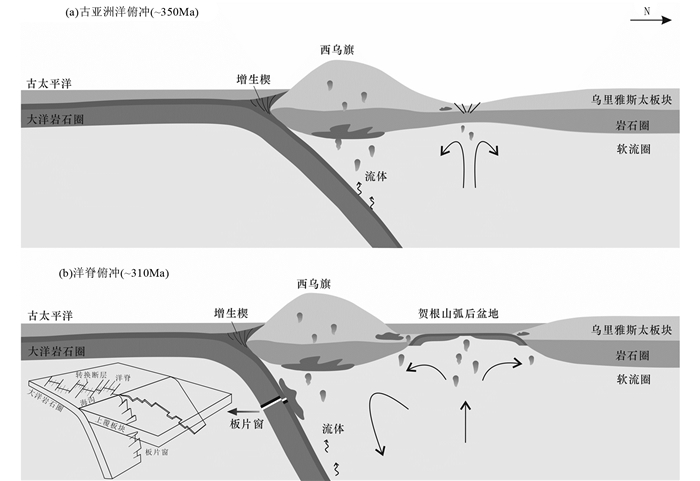
|
图 12 内蒙古中部西乌旗地区晚石炭世地球动力学演化简图(据Yang et al., 2020修改) Fig. 12 Sketch geodynamic evolution of the Carboniferous in West Ujimqin of central Inner Mongolia(modified after Yang et al., 2020) |
由于其时间上的一致性和岩石组合上的相似性,猴头庙辉长岩-Ⅰ型花岗岩、二连浩特富闪深成岩-A型花岗岩(Yuan et al., 2022)和南蒙古地体辉绿岩-Ⅰ型花岗岩(Hu et al., 2017)可以作为指示洋脊俯冲的标志性双峰式侵入岩建造。
6 结论(1) 内蒙古中部西乌旗地区猴头庙辉长岩-花岗岩系列约于晚石炭世(307~305Ma)侵位。
(2) 猴头庙辉长岩主要组成包括斜长石、辉石和角闪石;呈现镁质和钙碱性特征;富集大离子亲石元素,亏损高场强元素;具有较低的全岩ISr(t)、低正的全岩εNd(t)和正锆石εHf(t)值。元素与同位素地球化学示踪表明猴头庙辉长岩形成于俯冲板片流体交代亏损岩石圈地幔部分熔融及其后结晶分异作用。
(3) 猴头庙花岗岩呈现高硅碱、贫铁镁和弱过铝等特征,属于高分异Ⅰ型花岗岩;具有中等放射成因全岩ISr(t)、全岩εNd(t)、锆石εHf(t)和高锆石δ18O;这些元素与同位素特征指示一个由中元古代和古生代多期增生物质构成的复合中基性地壳,其部分熔融析出原始高钾钙碱性Ⅰ型酸性岩浆并经历结晶分异形成猴头庙高硅花岗岩。
(4) 与区域同期双峰式岩浆建造一道,猴头庙辉长岩-花岗岩系列构成见证内蒙古中部晚石炭世末期古亚洲洋洋脊俯冲过程的空间标志。
致谢 衷心感谢两位审稿专家提出的建设性修改意见;感谢岩石圈演化国家重点实验室工作人员在SIMS锆石U-Pb定年、锆石Hf-O同位素、全岩Sr-Nd同位素以及主量元素分析中提供的帮助。
Altherr R and Siebel W. 2002. Ⅰ-type plutonism in a continental back-arc setting: Miocene granitoids and monzonites from the central Aegean Sea, Greece. Contributions to Mineralogy and Petrology, 143(4): 397-415 DOI:10.1007/s00410-002-0352-y
|
Badarch G, Cunningham WD and Windley BF. 2002. A new terrane subdivision for Mongolia: Implications for the Phanerozoic crustal growth of Central Asia. Journal of Asian Earth Sciences, 21(1): 87-110 DOI:10.1016/S1367-9120(02)00017-2
|
Ballouard C, Poujol M, Boulvais P, Branquet Y, Tartèse R and Vigneresse JL. 2016. Nb-Ta fractionation in peraluminous granites: A marker of the magmatic-hydrothermal transition. Geology, 44(3): 231-234 DOI:10.1130/G37475.1
|
Bao QZ, Zhang CJ, Wu ZL, Wang H, Li W, Su YZ, Sang JH and Liu YS. 2006. Carboniferous-Permian marine lithostratigraphy and sequence stratigraphy in Xi Ujimqin Qi, southeastern Inner Mongolia, China. Geological Bulletin of China, 25(5): 572-579 (in Chinese with English abstract)
|
Bao QZ, Zhang CJ, Wu ZL, Wang H, Li W, Sang JH and Liu YS. 2007. SHRIMP U-Pb zircon geochronology of a Carboniferous quartz-diorite in Baiyingaole area, Inner Mongolia and its implications. Journal of Jilin University (Earth Science Edition), 37(1): 15-23 (in Chinese with English abstract)
|
Bau M. 1996. Controls on the fractionation of isovalent trace elements in magmatic and aqueous systems: Evidence from Y/Ho, Zr/Hf, and lanthanide tetrad effect. Contributions to Mineralogy and Petrology, 123(3): 323-333 DOI:10.1007/s004100050159
|
Beard JS and Lofgren GE. 1991. Dehydration melting and water-saturated melting of basaltic and andesitic greenstones and amphibolites at 1, 3, and 6.9kb. Journal of Petrology, 32(2): 365-401 DOI:10.1093/petrology/32.2.365
|
Bonin B. 2004. Do coeval mafic and felsic magmas in post-collisional to within-plate regimes necessarily imply two contrasting, mantle and crustal, sources? A review. Lithos, 78(1-2): 1-24 DOI:10.1016/j.lithos.2004.04.042
|
Chai H, Wang QF, Tao JX, Santosh M, Ma TF and Zhao R. 2018. Late Carboniferous to Early Permian magmatic pulses in the Uliastai continental margin linked to slab rollback: Implications for evolution of the Central Asian Orogenic Belt. Lithos, 308-309: 134-158 DOI:10.1016/j.lithos.2018.02.031
|
Chappell BW. 1999. Aluminium saturation in I- and S-type granites and the characterization of fractionated haplogranites. Lithos, 46(3): 535-551 DOI:10.1016/S0024-4937(98)00086-3
|
Chen B, Jahn BM, Wilde S and Xu B. 2000. Two contrasting Paleozoic magmatic belts in northern Inner Mongolia, China: Petrogenesis and tectonic implications. Tectonophysics, 328(1-2): 157-182 DOI:10.1016/S0040-1951(00)00182-7
|
Cheng YH, Teng XJ, Li YF, Li M and Zhang TF. 2014. Early Permian East-Ujimqin mafic-ultramafic and granitic rocks from the Xing'an-Mongolian Orogenic Belt, North China: Origin, chronology, and tectonic implications. Journal of Asian Earth Sciences, 96: 361-373 DOI:10.1016/j.jseaes.2014.09.027
|
Cheng YH, Zhang TF, Li YF, Li M, Niu WC, Teng XJ, Duan LF, Liu Y, Du YL and Hu XJ. 2016. Discovery of the Early Permian ultramafic rock in Dong Ujimqi, Inner Mongolia and its tectonic implications. Acta Geologica Sinica, 90(1): 115-125 (in Chinese with English abstract)
|
Cherniak DJ and Watson EB. 2003. Diffusion in zircon. Reviews in Mineralogy and Geochemistry, 53(1): 113-143 DOI:10.2113/0530113
|
Clemens JD, Darbyshire DPF and Flinders J. 2009. Sources of post-orogenic calc-alkaline magmas: The Arrochar and Garabal Hill-Glen Fyne complexes, Scotland. Lithos, 112(3-4): 524-542 DOI:10.1016/j.lithos.2009.03.026
|
Clemens JD, Stevens G and Farina F. 2011. The enigmatic sources of Ⅰ-type granites: The peritectic connexion. Lithos, 126(3-4): 174-181 DOI:10.1016/j.lithos.2011.07.004
|
Cole RB and Stewart BW. 2009. Continental margin volcanism at sites of spreading ridge subduction: Examples from southern Alaska and western California. Tectonophysics, 464(1-4): 118-136 DOI:10.1016/j.tecto.2007.12.005
|
Collins WJ, Belousova EA, Kemp AIS and Murphy JB. 2011. Two contrasting Phanerozoic orogenic systems revealed by hafnium isotope data. Nature Geoscience, 4(5): 333-337 DOI:10.1038/ngeo1127
|
Ducea MN, Saleeby JB and Bergantz G. 2015. The architecture, chemistry, and evolution of continental magmatic arcs. Annual Review of Earth and Planetary Sciences, 43: 299-331 DOI:10.1146/annurev-earth-060614-105049
|
Eizenhöfer PR, Zhao GC, Zhang J and Sun M. 2014. Final closure of the Paleo-Asian Ocean along the Solonker Suture Zone: Constraints from geochronological and geochemical data of Permian volcanic and sedimentary rocks. Tectonics, 33(4): 441-463 DOI:10.1002/2013TC003357
|
Eizenhöfer PR, Zhao GC, Sun M, Zhang J, Han YG and Hou WZ. 2015. Geochronological and Hf isotopic variability of detrital zircons in Paleozoic strata across the accretionary collision zone between the North China Craton and Mongolian arcs and tectonic implications. Geological Society of America Bulletin, 127(9-10): 1422-1436 DOI:10.1130/B31175.1
|
Eizenhöfer PR and Zhao GC. 2018. Solonker Suture in East Asia and its bearing on the final closure of the eastern segment of the Palaeo-Asian Ocean. Earth-Science Reviews, 186: 153-172 DOI:10.1016/j.earscirev.2017.09.010
|
Espinoza F, Morata D, Polvé M, Lagabrielle Y, Maury RC, Guivel C, Cotten J, Bellon H and Suárez M. 2008. Bimodal back-arc alkaline magmatism after ridge subduction: Pliocene felsic rocks from Central Patagonia (47°S). Lithos, 101(3-4): 191-217 DOI:10.1016/j.lithos.2007.07.002
|
Feng GY, Dilek Y, Niu XL, Liu F and Yang JS. 2021. Geochemistry and geochronology of OIB-type, Early Jurassic magmatism in the Zhangguangcai range, NE China, as a result of continental back-arc extension. Geological Magazine, 158(1): 143-157 DOI:10.1017/S0016756818000705
|
Ferré EC and Leake BE. 2001. Geodynamic significance of early orogenic high-K crustal and mantle melts: Example of the Corsica Batholith. Lithos, 59(1-2): 47-67 DOI:10.1016/S0024-4937(01)00060-3
|
Frost BR, Barnes CG, Collins WJ, Arculus RJ, Ellis DJ and Frost CD. 2001. A geochemical classification for granitic rocks. Journal of Petrology, 42(11): 2033-2048 DOI:10.1093/petrology/42.11.2033
|
Fu D, Huang B, Peng SB, Kusky TM, Zhou WX and Ge MC. 2016. Geochronology and geochemistry of Late Carboniferous volcanic rocks from northern Inner Mongolia, North China: Petrogenesis and tectonic implications. Gondwana Research, 36: 545-560 DOI:10.1016/j.gr.2015.08.007
|
Geng HY, Sun M, Yuan C, Xiao WJ, Xian WS, Zhao GC, Zhang LF, Wong K and Wu FY. 2009. Geochemical, Sr-Nd and zircon U-Pb-Hf isotopic studies of Late Carboniferous magmatism in the West Junggar, Xinjiang: Implications for ridge subduction?. Chemical Geology, 266(3-4): 364-389 DOI:10.1016/j.chemgeo.2009.07.001
|
Glazner AF. 2007. Thermal limitations on incorporation of wall rock into magma. Geology, 35(4): 319-322 DOI:10.1130/G23134A.1
|
Goldstein SL, O'Nions RK and Hamilton PJ. 1984. A Sm-Nd isotopic study of atmospheric dusts and particulates from major river systems. Earth and Planetary Science Letters, 70(2): 221-236 DOI:10.1016/0012-821X(84)90007-4
|
Griffin WL, Pearson NJ, Belousova E, Jackson SE, Van Achterbergh E, O'Reilly SY and Shee SR. 2000. The Hf isotope composition of cratonic mantle: LAM-MC-ICPMS analysis of zircon megacrysts in kimberlites. Geochimica et Cosmochimica Acta, 64(1): 133-147 DOI:10.1016/S0016-7037(99)00343-9
|
Hirose K and Kushiro I. 1998. The effect of melt segregation on polybaric mantle melting: Estimation from the incremental melting experiments. Physics of the Earth and Planetary Interiors, 107(1-3): 111-118 DOI:10.1016/S0031-9201(97)00129-5
|
Hoffer G, Eissen JP, Beate B, Bourdon E, Fornari M and Cotten J. 2008. Geochemical and petrological constraints on rear-arc magma genesis processes in Ecuador: The Puyo cones and Mera lavas volcanic formations. Journal of Volcanology and Geothermal Research, 176(1): 107-118 DOI:10.1016/j.jvolgeores.2008.05.023
|
Hong DW, Chang WJ, Huang HZ, Xiao YJ, Xu HM and Jin MY. 1994. The Permian alkaline granites in Central Inner Mongolia and their geodynamic significance. Journal of Southeast Asian Earth Sciences, 10(3-4): 169-176 DOI:10.1016/0743-9547(94)90017-5
|
Hu CS, Li WB, Huang QY, Xu C, Zhou JA and Li ZH. 2017. Geochemistry and petrogenesis of Late Carboniferous igneous rocks from southern Mongolia: Implications for the post-collisional extension in the southeastern Central Asian Orogenic Belt. Journal of Asian Earth Sciences, 144: 141-154 DOI:10.1016/j.jseaes.2017.01.011
|
Huang C, Wang H, Yang JH, Ramezani J, Yang C, Zhang SB, Yang YH, Xia XP, Feng LJ, Lin J, Wang TT, Ma Q, He HY, Xie LW and Wu ST. 2020. SA01: A proposed zircon reference material for microbeam U-Pb age and Hf-O isotopic determination. Geostandards and Geoanalytical Research, 44(1): 103-123 DOI:10.1111/ggr.12307
|
Ishizuka O, Tani K and Reagan MK. 2014. Izu-Bonin-Mariana forearc crust as a modern ophiolite analogue. Elements, 10(2): 115-120 DOI:10.2113/gselements.10.2.115
|
Jahn BM, Wu FY and Chen B. 2000. Massive granitoid generation in Central Asia: Nd isotope evidence and implication for continental growth in the Phanerozoic. Episodes, 23(2): 82-92 DOI:10.18814/epiiugs/2000/v23i2/001
|
Jahn BM. 2004. The Central Asian Orogenic Belt and growth of the continental crust in the Phanerozoic. In: Malpas J, Fletcher CJN, Ali JR and Aitchison JC. Geological Society, London, Special Publications, 226(1): 73-100
|
Jahn BM, Litvinovsky BA, Zanvilevich AN and Reichow M. 2009. Peralkaline granitoid magmatism in the Mongolian-Transbaikalian belt: Evolution, petrogenesis and tectonic significance. Lithos, 113(3-4): 521-539 DOI:10.1016/j.lithos.2009.06.015
|
Jian P, Liu DY, Kröner A, Windley BF, Shi YR, Zhang FQ, Shi GH, Miao LC, Zhang W, Zhang Q, Zhang LQ and Ren JS. 2008. Time scale of an Early to Mid-Paleozoic orogenic cycle of the long-lived Central Asian Orogenic Belt, Inner Mongolia of China: Implications for continental growth. Lithos, 101(3-4): 233-259 DOI:10.1016/j.lithos.2007.07.005
|
Jian P, Liu DY, Kröner A, Windley BF, Shi YR, Zhang W, Zhang FQ, Miao LC, Zhang LQ and Tomurhuu D. 2010. Evolution of a Permian intraoceanic arc-trench system in the Solonker suture zone, Central Asian Orogenic Belt, China and Mongolia. Lithos, 118(1-2): 169-190 DOI:10.1016/j.lithos.2010.04.014
|
Jiang JY and Zhu YF. 2020. Petrogenesis of the Early Carboniferous Xilinhot gabbro-diorite pluton in central Inner Mongolia: Magma evolution and tectonic significance. Lithos, 354-355: 105339 DOI:10.1016/j.lithos.2019.105339
|
Jung S and Pfänder JA. 2007. Source composition and melting temperatures of orogenic granitoids: Constraints from CaO/Na2O, Al2O3/TiO2 and accessory mineral saturation thermometry. European Journal of Mineralogy, 19(6): 859-870 DOI:10.1127/0935-1221/2007/0019-1774
|
Karsli O, Dokuz A, Uysal İ, Aydin F, Chen B, Kandemir R and Wijbrans J. 2010. Relative contributions of crust and mantle to generation of Campanian high-K calc-alkaline Ⅰ-type granitoids in a subduction setting, with special reference to the Harşit Pluton, Eastern Turkey. Contributions to Mineralogy and Petrology, 160(4): 467-487 DOI:10.1007/s00410-010-0489-z
|
Kaur P, Chaudhri N, Raczek I, Kröner A and Hofmann AW. 2009. Record of 1.82Ga Andean-type continental arc magmatism in NE Rajasthan, India: Insights from zircon and Sm-Nd ages, combined with Nd-Sr isotope geochemistry. Gondwana Research, 16(1): 56-71 DOI:10.1016/j.gr.2009.03.009
|
Kemp AIS, Wormald RJ, Whitehouse MJ and Price RC. 2005. Hf isotopes in zircon reveal contrasting sources and crystallization histories for alkaline to peralkaline granites of Temora, southeastern Australia. Geology, 33(10): 797-800 DOI:10.1130/G21706.1
|
Kilian R and Stern CR. 2002. Constraints on the interaction between slab melts and the mantle wedge from adakitic glass in peridotite xenoliths. European Journal of Mineralogy, 14(1): 25-36 DOI:10.1127/0935-1221/2002/0014-0025
|
King EM, Valley JW, Davis DW and Edwards GR. 1998. Oxygen isotope ratios of Archean plutonic zircons from granite-greenstone belts of the Superior Province: Indicator of magmatic source. Precambrian Research, 92(4): 365-387 DOI:10.1016/S0301-9268(98)00082-5
|
King PL, Chappell BW, Allen CM and White AJR. 2001. Are A-type granites the high-temperature felsic granites? Evidence from fractionated granites of the Wangrah Suite. Australian Journal of Earth Sciences, 48(4): 501-514 DOI:10.1046/j.1440-0952.2001.00881.x
|
Lackey JS, Valley JW and Saleeby JB. 2005. Supracrustal input to magmas in the deep crust of Sierra Nevada batholith: Evidence from high-δ18O zircon. Earth and Planetary Science Letters, 235(1-2): 315-330 DOI:10.1016/j.epsl.2005.04.003
|
Lagabrielle Y, Le Moigne J, Maury RC, Cotten J and Bourgois J. 1994. Volcanic record of the subduction of an active spreading ridge, Taitao Peninsula (southern Chile). Geology, 22(6): 515-518 DOI:10.1130/0091-7613(1994)022<0515:VROTSO>2.3.CO;2
|
Le Maitre RW, Bateman P and Dudek A. 1989. A Classification of Igneous Rocks and Glossary of Terms: Recommendations of the International Union of Geological Sciences, Subcommission on the Systematics of Igneous Rocks. Oxford: Blackwell
|
Lee CTA and Morton DM. 2015. High silica granites: Terminal porosity and crystal settling in shallow magma chambers. Earth and Planetary Science Letters, 409: 23-31 DOI:10.1016/j.epsl.2014.10.040
|
Li CF, Chu ZY, Guo JH, Li YL, Yang YH and Li XH. 2015. A rapid single column separation scheme for high-precision Sr-Nd-Pb isotopic analysis in geological samples using thermal ionization mass spectrometry. Analytical Methods, 7(11): 4793-4802 DOI:10.1039/C4AY02896A
|
Li GZ, Wang YJ, LI CY, Bai YM, Xue JP, Zhao GM, Bo HJ, Liang YS and Liu W. 2017. Discovery of Early Permian radiolarian fauna in the Solon Obo ophiolite belt, Inner Mongolia and its geological significance. Chinese Science Bulletin, 62(5): 400-406 (in Chinese) DOI:10.1360/N972016-00703
|
Li JL, Liu JG, Wang YJ, Zhu DC and Wu C. 2021. Late Carboniferous to Early Permian ridge subduction identified in the southeastern Central Asian Orogenic Belt: Implications for the architecture and growth of continental crust in accretionary orogens. Lithos, 384-385: 105969 DOI:10.1016/j.lithos.2021.105969
|
Li MT, Tang J, Wang ZW, Xu B, Zhang YJ, Tian YJ and Zhai P. 2020. Geochronology and geochemistry of the Early Carboniferous volcanic rocks in Sonid Zuoqi, Inner Mongolia: Implication for the Carboniferous tectonic evolution and crustal nature of the eastern Central Asia Orogenic Belt. Acta Petrologica Sinica, 36(3): 799-819 (in Chinese with English abstract) DOI:10.18654/1000-0569/2020.03.10
|
Li XH, Liu Y, Li QL, Guo CH and Chamberlain KR. 2009. Precise determination of Phanerozoic zircon Pb/Pb age by multicollector SIMS without external standardization. Geochemistry, Geophysics, Geosystems, 10(4): Q04010
|
Li XH, Long WG, Li QL, Liu Y, Zheng YF, Yang YH, Chamberlain KR, Wan DF, Guo CH, Wang XC and Tao H. 2010. Penglai zircon megacrysts: A potential new working reference material for microbeam determination of Hf-O isotopes and U-Pb age. Geostandards and Geoanalytical Research, 34(2): 117-134 DOI:10.1111/j.1751-908X.2010.00036.x
|
Li XH, Tang GQ, Gong B, Yang YH, Hou KJ, Hu ZC, Li QL, Liu Y and Li WX. 2013. Qinghu zircon: A working reference for microbeam analysis of U-Pb age and Hf and O isotopes. Chinese Science Bulletin, 58(36): 4647-4654 DOI:10.1007/s11434-013-5932-x
|
Li YJ, Wang JF, Li HY, Dong PP, He QL, Zhang HC and Song P. 2013. Geochemical characteristics of Baiyinbulage ophiolite in Xi Ujimqin Banner, Inner Mongolia. Acta Petrologica Sinica, 29(8): 2719-2730 (in Chinese with English abstract)
|
Li YJ, Wang JF, Li HY and Dong PP. 2015. Recognition of Meilaotewula ophiolite in Xi Ujimqin Banner, Inner Mongolia. Acta Petrologica Sinica, 31(5): 1461-1470 (in Chinese with English abstract)
|
Li YJ, Wang GH, Santosh M, Wang JF, Dong PP and Li HY. 2018. Supra-subduction zone ophiolites from Inner Mongolia, North China: Implications for the tectonic history of the southeastern Central Asian Orogenic Belt. Gondwana Research, 59: 126-143 DOI:10.1016/j.gr.2018.02.018
|
Li YJ, Wang GH, Santosh M, Wang JF, Dong PP and Li HY. 2020. Subduction initiation of the SE Paleo-Asian Ocean: Evidence from a well preserved intra-oceanic forearc ophiolite fragment in central Inner Mongolia, North China. Earth and Planetary Science Letters, 535: 116087 DOI:10.1016/j.epsl.2020.116087
|
Li YL, Zhou HW, Brouwer FM, Xiao WJ, Wijbrans JR and Zhong ZQ. 2014. Early Paleozoic to Middle Triassic bivergent accretion in the Central Asian Orogenic Belt: Insights from zircon U-Pb dating of ductile shear zones in central Inner Mongolia, China. Lithos, 205: 84-111 DOI:10.1016/j.lithos.2014.06.017
|
Li YL, Brouwer FM, Xiao WJ and Zheng JP. 2017. Late Devonian to Early Carboniferous arc-related magmatism in the Baolidao arc, Inner Mongolia, China: Significance for southward accretion of the eastern Central Asian orogenic belt. GSA Bulletin, 129(5-6): 677-697 DOI:10.1130/B31511.1
|
Li Z, Qiu JS and Xu XS. 2012. Geochronological, geochemical and Sr-Nd-Hf isotopic constraints on petrogenesis of Late Mesozoic gabbro-granite complexes on the southeast coast of Fujian, South China: Insights into a depleted mantle source region and crust-mantle interactions. Geological Magazine, 149(3): 459-482 DOI:10.1017/S0016756811000793
|
Lindline J, Crawford WA and Crawford ML. 2004. A bimodal volcanic-plutonic system: The Zarembo Island extrusive suite and the Burnett Inlet intrusive complex. Canadian Journal of Earth Sciences, 41(4): 355-375 DOI:10.1139/e04-009
|
Litvinovsky BA, Jahn BM and Eyal M. 2015. Mantle-derived sources of syenites from the A-type igneous suites: New approach to the provenance of alkaline silicic magmas. Lithos, 232: 242-265 DOI:10.1016/j.lithos.2015.06.008
|
Liu CF, Zhou ZG, Wang GS, Wu C, Li HY and Ma SW. 2021. Carboniferous ridge subduction in the Xingmeng Orogenic Belt: Constraints from geochronological, geochemical, and Sr-Nd-Hf isotopic analysis of strongly peraluminous granites and gabbro-diorites in the Xilinhot micro-continent. Geoscience Frontiers, 12(3): 101103 DOI:10.1016/j.gsf.2020.10.008
|
Liu JF, Li JY, Chi XG, Qu JF, Hu ZC, Fang S and Zhang Z. 2013. A Late-Carboniferous to early Early-Permian subduction-accretion complex in Daqing pasture, southeastern Inner Mongolia: Evidence of northward subduction beneath the Siberian paleoplate southern margin. Lithos, 177: 285-296 DOI:10.1016/j.lithos.2013.07.008
|
Liu YS, Zong KQ, Kelemen PB and Gao S. 2008. Geochemistry and magmatic history of eclogites and ultramafic rocks from the Chinese continental scientific drill hole: Subduction and ultrahigh-pressure metamorphism of lower crustal cumulates. Chemical Geology, 247(1-2): 133-153 DOI:10.1016/j.chemgeo.2007.10.016
|
Lugmair GW and Marti K. 1978. Lunar initial 143Nd/144Nd: Differential evolution of the lunar crust and mantle. Earth and Planetary Science Letters, 39(3): 349-357 DOI:10.1016/0012-821X(78)90021-3
|
Ma SW, Liu CF, Xu ZQ, Zhou ZG, Dong JY and Li HY. 2017. Geochronology, geochemistry and tectonic significance of the Early Carboniferous gabbro and diorite plutons in West Ujimqin, Inner Mongolia. Journal of Earth Science, 28(2): 249-264 DOI:10.1007/s12583-016-0912-2
|
Maniar PD and Piccoli PM. 1989. Tectonic discrimination of granitoids. GSA Bulletin, 101(5): 635-643 DOI:10.1130/0016-7606(1989)101<0635:TDOG>2.3.CO;2
|
McMillan A, Harris NBW, Holness M, Ashwal L, Kelley S and Rambeloson R. 2003. A granite-gabbro complex from Madagascar: Constraints on melting of the lower crust. Contributions to Mineralogy and Petrology, 145(5): 585-599 DOI:10.1007/s00410-003-0470-1
|
Miao LC, Fan WM, Liu DY, Zhang FQ, Shi YR and Guo F. 2008. Geochronology and geochemistry of the Hegenshan ophiolitic complex: Implications for late-stage tectonic evolution of the Inner Mongolia-Daxinganling Orogenic Belt, China. Journal of Asian Earth Sciences, 32(5-6): 348-370 DOI:10.1016/j.jseaes.2007.11.005
|
Moghazi AM. 2003. Geochemistry and petrogenesis of a high-K calc-alkaline Dokhan volcanic suite, South Safaga area, Egypt: The role of Late Neoproterozoic crustal extension. Precambrian Research, 125(1-2): 161-178 DOI:10.1016/S0301-9268(03)00110-4
|
Mullen ED. 1983. MnO/TiO2/P2O5: A minor element discriminant for basaltic rocks of oceanic environments and its implications for petrogenesis. Earth and Planetary Science Letters, 62(1): 53-62 DOI:10.1016/0012-821X(83)90070-5
|
Pang CJ, Wang XC, Wen SN, Bryan K, Wang YY and Liao W. 2018. Petrogenesis of Late Carboniferous gabbroic intrusions in the Xilinhot region of Inner Mongolia: Products of partial melting of a hydrous mantle source in an intra-continental extensional setting. Acta Petrologica Sinica, 34(10): 2956-2972 (in Chinese with English abstract)
|
Patiño Douce AE. 1997. Generation of metaluminous A-type granites by low-pressure melting of calc-alkaline granitoids. Geology, 25(8): 743-746 DOI:10.1130/0091-7613(1997)025<0743:GOMATG>2.3.CO;2
|
Patiño Douce AE and McCarthy TC. 1998. Melting of crustal rocks during continental collision and Subduction. In: Hacker BR and Liou JG (eds.). When Continents Collide: Geodynamics and Geochemistry of Ultrahigh-Pressure Rocks. Dordrecht: Springer, 27-55
|
Pearce JA, Kempton PD, Nowell GM and Noble SR. 1999. Hf-Nd element and isotope perspective on the nature and provenance of mantle and subduction components in western Pacific arc-basin systems. Journal of Petrology, 40(11): 1579-1611 DOI:10.1093/petroj/40.11.1579
|
Peck WH and Valley JW. 2000. Large crustal input to high δ18O anorthosite massifs of the southern Grenville Province: New evidence from the Morin Complex, Quebec. Contributions to Mineralogy and Petrology, 139(4): 402-417 DOI:10.1007/s004100000149
|
Peng P, Guo JH, Zhai MG and Bleeker W. 2010. Paleoproterozoic gabbronoritic and granitic magmatism in the northern margin of the North China Craton: Evidence of crust-mantle interaction. Precambrian Research, 183(3): 635-659 DOI:10.1016/j.precamres.2010.08.015
|
Pérez-Soba C and Villaseca C. 2010. Petrogenesis of highly fractionated Ⅰ-type peraluminous granites: La Pedriza pluton (Spanish Central System). Geologica Acta, 8(2): 131-149
|
Plank T and Langmuir CH. 1993. Tracing trace elements from sediment input to volcanic output at subduction zones. Nature, 362(6422): 739-743 DOI:10.1038/362739a0
|
Plank T. 2005. Constraints from thorium/lanthanum on sediment recycling at subduction zones and the evolution of the continents. Journal of Petrology, 46(5): 921-944 DOI:10.1093/petrology/egi005
|
Regelous M, Haase KM, Freund S, Keith M, Weinzierl CG, Beier C, Brandl PA, Endres T and Schmidt H. 2014. Formation of the Troodos ophiolite at a triple junction: Evidence from trace elements in volcanic glass. Chemical Geology, 386: 66-79 DOI:10.1016/j.chemgeo.2014.08.006
|
Renna MR, Tribuzio R and Tiepolo M. 2006. Interaction between basic and acid magmas during the latest stages of the post-collisional Variscan evolution: Clues from the gabbro-granite association of Ota (Corsica-Sardinia batholith). Lithos, 90(1-2): 92-110 DOI:10.1016/j.lithos.2006.02.003
|
Renna MR, Tribuzio R and Braga R. 2013. Petrogenetic relationships between peralkaline rhyolite dykes and mafic rocks in the post-Variscan gabbroic complex from Bocca di Tenda (northern Corsica, France). Contributions to Mineralogy and Petrology, 165(6): 1073-1085 DOI:10.1007/s00410-012-0848-z
|
Roberts MP and Clemens JD. 1993. Origin of high-potassium, calc-alkaline, Ⅰ-type granitoids. Geology, 21(9): 825-828 DOI:10.1130/0091-7613(1993)021<0825:OOHPTA>
|
Roberts MP, Pin C, Clemens JD and Paquette JL. 2000. Petrogenesis of mafic to felsic plutonic rock associations: The calc-alkaline Quérigut complex, French Pyrenees. Journal of Petrology, 41(6): 809-844 DOI:10.1093/petrology/41.6.809
|
Rudnick RL and Gao S. 2003. Composition of the continental crust. Treatise on Geochemistry, 3: 1-64
|
Şengör AMC, Natal'in BA and Burtman VS. 1993. Evolution of the Altaid tectonic collage and Palaeozoic crustal growth in Eurasia. Nature, 364(6435): 299-307 DOI:10.1038/364299a0
|
Shang QH. 2004. Occurrences of Permian radiolarians in central and eastern Nei Mongol (Inner Mongolia) and their geological significance to the Northern China Orogen. Chinese Science Bulletin, 49(24): 2613-2619 DOI:10.1360/04wd0069
|
Shao JA, Tang KD and He GQ. 2014. Early Permian tectono-palaeogeographic reconstruction of Inner Mongolia, China. Acta Petrologica Sinica, 30(7): 1858-1866 (in Chinese with English abstract)
|
Shao JA, Tian W, Tang KD and Wang Y. 2015. Petrogenesis and tectonic settings of the Late Carboniferous high Mg basalts of Inner Mongolia. Earth Science Frontiers, 22(5): 171-181 (in Chinese with English abstract)
|
Shao JA, Tian W, Tang KD and Zhou XH. 2018. Preliminary discussion on the role of microcontinental blocks in the evolution of the Central Asian Orogenic Belt: Taking the Xilinhaote microcontinental block as an example. Earth Science Frontiers, 25(4): 1-10 (in Chinese with English abstract)
|
Shaw DM. 1970. Trace element fractionation during anatexis. Geochimica et Cosmochimica Acta, 34(2): 237-243 DOI:10.1016/0016-7037(70)90009-8
|
Shervais JW. 1982. Ti-Ⅴ plots and the petrogenesis of modern and ophiolitic lavas. Earth and Planetary Science Letters, 59(1): 101-118 DOI:10.1016/0012-821X(82)90120-0
|
Shinjo R and Kato Y. 2000. Geochemical constraints on the origin of bimodal magmatism at the Okinawa Trough, an incipient back-arc basin. Lithos, 54(3-4): 117-137 DOI:10.1016/S0024-4937(00)00034-7
|
Sisson TW, Ratajeski K, Hankins WB and Glazner AF. 2005. Voluminous granitic magmas from common basaltic sources. Contributions to Mineralogy and Petrology, 148(6): 635-661 DOI:10.1007/s00410-004-0632-9
|
Sisson VB, Pavlis TL, Roeske SM and Thorkelson DJ. 2003. Introduction: An overview of ridge-trench interactions in modern and ancient settings. In: Sisson VB, Roeske SM and Pavlis TL (eds.). Geology of a Transpressional Orogen Developed During Ridge-Trench Interaction along the North Pacific Margin. New York: Geological Society of America, 1-18
|
Skjerlie KP and Johnston AD. 1993. Fluid-absent melting behavior of an F-rich tonalitic gneiss at mid-crustal pressures: Implications for the generation of anorogenic granites. Journal of Petrology, 34(4): 785-815 DOI:10.1093/petrology/34.4.785
|
Sláma J, Košler J, Condon DJ, Crowley JL, Gerdes A, Hanchar JM, Horstwood MSA, Morris GA, Nasdala L, Norberg N, Schaltegger U, Schoene B, Tubrett MN and Whitehouse MJ. 2008. Plešovice zircon: A new natural reference material for U-Pb and Hf isotopic microanalysis. Chemical Geology, 249(1-2): 1-35 DOI:10.1016/j.chemgeo.2007.11.005
|
Song SG, Wang MM, Xu X, Wang C, Niu YL, Allen MB and Su L. 2015. Ophiolites in the Xing'an-Inner Mongolia accretionary belt of the CAOB: Implications for two cycles of seafloor spreading and accretionary orogenic events. Tectonics, 34(10): 2221-2248 DOI:10.1002/2015TC003948
|
Steiger RH and Jäger E. 1977. Subcommission on geochronology: Convention on the use of decay constants in geo- and cosmochronology. Earth and Planetary Science Letters, 36(3): 359-362 DOI:10.1016/0012-821X(77)90060-7
|
Stein M, Navon O and Kessel R. 1997. Chromatographic metasomatism of the Arabian-Nubian lithosphere. Earth and Planetary Science Letters, 152(1-4): 75-91 DOI:10.1016/S0012-821X(97)00156-8
|
Stepanov A, Mavrogenes JA, Meffre S and Davidson P. 2014. The key role of mica during igneous concentration of tantalum. Contributions to Mineralogy and Petrology, 167(6): 1009 DOI:10.1007/s00410-014-1009-3
|
Sun LX, Zhang Y, Li YF, Xu F and Ren BF. 2020. Zircon U-Pb age and geochemistry of the Mesoproterozoic gneissic granite from Abaga Banner, Inner Mongolia and its tectonic significances. Acta Petrologica Sinica, 36(3): 781-798 (in Chinese with English abstract) DOI:10.18654/1000-0569/2020.03.09
|
Sun SS and McDonough WF. 1989. Chemical and isotopic systematics of oceanic basalts: Implications for mantle composition and processes. In: Saunders AD and Norry MJ (eds.). Magmatism in the Ocean Basins. Geological Society, London, Special Publication, 42(1): 313-345
|
Tang GJ, Wang Q, Wyman DA, Li ZX, Zhao ZH, Jia XH and Jiang ZQ. 2010. Ridge subduction and crustal growth in the Central Asian Orogenic Belt: Evidence from Late Carboniferous adakites and high-Mg diorites in the western Junggar region, northern Xinjiang (West China). Chemical Geology, 277(3-4): 281-300 DOI:10.1016/j.chemgeo.2010.08.012
|
Tang GJ, Wang Q, Wyman DA, Li ZX, Zhao ZH and Yang YH. 2012. Late Carboniferous high εNd(t)-εHf(t) granitoids, enclaves and dikes in western Junggar, NW China: Ridge-subduction-related magmatism and crustal growth. Lithos, 140-141: 86-102 DOI:10.1016/j.lithos.2012.01.025
|
Tang GJ, Chung SL, Wang Q, Wyman DA, Dan W, Chen HY and Zhao ZH. 2014. Petrogenesis of a Late Carboniferous mafic dike-granitoid association in the western Tianshan: Response to the geodynamics of oceanic subduction. Lithos, 202-203: 85-99 DOI:10.1016/j.lithos.2014.04.010
|
Thorkelson DJ and Taylor RP. 1989. Cordilleran slab windows. Geology, 17(9): 833-836 DOI:10.1130/0091-7613(1989)017<0833:CSW>2.3.CO;2
|
Thorkelson DJ, Madsen JK and Sluggett CL. 2011. Mantle flow through the Northern Cordilleran slab window revealed by volcanic geochemistry. Geology, 39(3): 267-270 DOI:10.1130/G31522.1
|
Tong Y, Jahn BM, Wang T, Hong DW, Smith EI, Sun M, Gao JF, Yang QD and Huang W. 2015. Permian alkaline granites in the Erenhot-Hegenshan belt, northern Inner Mongolia, China: Model of generation, time of emplacement and regional tectonic significance. Journal of Asian Earth Sciences, 97: 320-336 DOI:10.1016/j.jseaes.2014.10.011
|
Turner S, Caulfield J, Turner M, van Keken P, Maury R, Sandiford M and Prouteau G. 2012. Recent contribution of sediments and fluids to the mantle's volatile budget. Nature Geoscience, 5(1): 50-54 DOI:10.1038/ngeo1325
|
Turner SP, Foden JD and Morrison RS. 1992. Derivation of some A-type magmas by fractionation of basaltic magma: An example from the Padthaway ridge, South Australia. Lithos, 28(2): 151-179 DOI:10.1016/0024-4937(92)90029-X
|
Valley JW, Kinny PD, Schulze DJ and Spicuzza MJ. 1998. Zircon megacrysts from kimberlite: Oxygen isotope variability among mantle melts. Contributions to Mineralogy and Petrology, 133(1-2): 1-11 DOI:10.1007/s004100050432
|
Valley JW. 2003. Oxygen isotopes in zircon. Reviews in Mineralogy and Geochemistry, 53(1): 343-385 DOI:10.2113/0530343
|
Wang Q, Tang GJ, Hao LL, Wyman D, Ma L, Dan W, Zhang XZ, Liu JH, Huang TY and Xu CB. 2020. Ridge subduction, magmatism, and metallogenesis. Science China (Earth Sciences), 63(10): 1499-1518 DOI:10.1007/s11430-019-9619-9
|
Wang XC, Wilde SA, Xu B and Pang CJ. 2016. Origin of arc-like continental basalts: Implications for deep-Earth fluid cycling and tectonic discrimination. Lithos, 261: 5-45 DOI:10.1016/j.lithos.2015.12.014
|
Wang XL. 2017. Some new research progresses and main scientific problems of granitic rocks. Acta Petrologica Sinica, 33(5): 1445-1458 (in Chinese with English abstract)
|
Wang ZW, Wang ZH, Zhang YJ, Xu B, Li YG, Tian YJ, Wang YC and Peng J. 2021. Linking 1.4~0.8Ga volcano-sedimentary records in eastern Central Asian orogenic belt with southern Laurentia in supercontinent cycles. Gondwana Research DOI:10.1016/j.gr.2021.09.019
|
Watson EB and Harrison TM. 1983. Zircon saturation revisited: Temperature and composition effects in a variety of crustal magma types. Earth and Planetary Science Letters, 64(2): 295-304 DOI:10.1016/0012-821X(83)90211-X
|
Wei RH, Gao YF, Xu SC, Xin HT, Santosh M, Liu YF and Lei SH. 2017. The volcanic succession of Baoligaomiao, central Inner Mongolia: Evidence for Carboniferous continental arc in the Central Asian Orogenic Belt. Gondwana Research, 51: 234-254 DOI:10.1016/j.gr.2017.08.005
|
Whalen JB, Currie KL and Chappell BW. 1987. A-type granites: Geochemical characteristics, discrimination and petrogenesis. Contributions to Mineralogy and Petrology, 95(4): 407-419 DOI:10.1007/BF00402202
|
Whalen JB and Hildebrand RS. 2019. Trace element discrimination of arc, slab failure, and A-type granitic rocks. Lithos, 348-349: 105179 DOI:10.1016/j.lithos.2019.105179
|
Whitaker ML, Nekvasil H, Lindsley DH and McCurry M. 2008. Can crystallization of olivine tholeiite give rise to potassic rhyolites? An experimental investigation. Bulletin of Volcanology, 70(3): 417-434 DOI:10.1007/s00445-007-0146-1
|
Wilde SA and Zhou JB. 2015. The Late Paleozoic to Mesozoic evolution of the eastern margin of the Central Asian Orogenic Belt in China. Journal of Asian Earth Sciences, 113: 909-921 DOI:10.1016/j.jseaes.2015.05.005
|
Williams IS. 1997. U-Th-Pb geochronology by ion microprobe. In: Society of Economic Geologists (ed.). Applications of Microanalytical Techniques to Understanding Mineralizing Processes. Society of Economic Geologists, 1-35
|
Windley BF, Alexeiev D, Xiao WJ, Kröner A and Badarch G. 2007. Tectonic models for accretion of the Central Asian Orogenic Belt. Journal of the Geological Society, 164(1): 31-47 DOI:10.1144/0016-76492006-022
|
Windley BF and Xiao WJ. 2018. Ridge subduction and slab windows in the Central Asian Orogenic Belt: Tectonic implications for the evolution of an accretionary orogen. Gondwana Research, 61: 73-87 DOI:10.1016/j.gr.2018.05.003
|
Woodhead JD, Hergt JM, Davidson JP and Eggins SM. 2001. Hafnium isotope evidence for 'conservative' element mobility during subduction zone processes. Earth and Planetary Science Letters, 192(3): 331-346 DOI:10.1016/S0012-821X(01)00453-8
|
Wu FY, Sun DY, Li HM, Jahn BM and Wilde S. 2002. A-type granites in northeastern China: Age and geochemical constraints on their petrogenesis. Chemical Geology, 187(1-2): 143-173 DOI:10.1016/S0009-2541(02)00018-9
|
Wu FY, Jahn BM, Wilde SA, Lo CH, Yui TF, Lin Q, Ge WC and Sun DY. 2003. Highly fractionated Ⅰ-type granites in NE China (Ⅰ): Geochronology and petrogenesis. Lithos, 66(3-4): 241-273 DOI:10.1016/S0024-4937(02)00222-0
|
Wu FY, Yang YH, Xie LW, Yang JH and Xu P. 2006. Hf isotopic compositions of the standard zircons and baddeleyites used in U-Pb geochronology. Chemical Geology, 234(1-2): 105-126 DOI:10.1016/j.chemgeo.2006.05.003
|
Wu FY, Li XH, Yang JH and Zheng YF. 2007. Discussions on the petrogenesis of granites. Acta Petrologica Sinica, 23(6): 1217-1238 (in Chinese with English abstract)
|
Wu FY, Liu XC, Ji WQ, Wang JM and Yang L. 2017. Highly fractionated granites: Recognition and research. Science China (Earth Sciences), 60(7): 1201-1219 DOI:10.1007/s11430-016-5139-1
|
Xiao WJ, Windley BF, Hao J and Zhai MG. 2003. Accretion leading to collision and the Permian Solonker suture, Inner Mongolia, China: Termination of the Central Asian Orogenic Belt. Tectonics, 22(6): 1069
|
Xiao WJ, Windley BF, Sun S, Li JL, Huang BC, Han CM, Yuan C, Sun M and Chen HL. 2015. A tale of amalgamation of three Permo-Triassic collage systems in central Asia: Oroclines, sutures, and terminal accretion. Annual Review of Earth and Planetary Sciences, 43: 477-507 DOI:10.1146/annurev-earth-060614-105254
|
Xiao WJ, Windley BF, Han CM, Liu W, Wan B, Zhang JE, Ao SJ, Zhang ZY and Song DF. 2018. Late Paleozoic to Early Triassic multiple roll-back and oroclinal bending of the Mongolia collage in Central Asia. Earth-Science Reviews, 186: 94-128 DOI:10.1016/j.earscirev.2017.09.020
|
Xu B, Charvet J, Chen Y, Zhao P and Shi GZ. 2013. Middle Paleozoic convergent orogenic belts in western Inner Mongolia (China): Framework, kinematics, geochronology and implications for tectonic evolution of the Central Asian Orogenic Belt. Gondwana Research, 23(4): 1342-1364 DOI:10.1016/j.gr.2012.05.015
|
Xu B, Zhao P, Wang YY, Liao W, Luo ZW, Bao QZ and Zhou YH. 2015. The pre-Devonian tectonic framework of Xing'an-Mongolia orogenic belt (XMOB) in North China. Journal of Asian Earth Sciences, 97: 183-196 DOI:10.1016/j.jseaes.2014.07.020
|
Xu B, Wang ZW, Zhang LY, Wang ZH, Yang ZN and He Y. 2018. The Xing-Meng intracontinent orogenic belt. Acta Petrologica Sinica, 34(10): 2819-2844 (in Chinese with English abstract)
|
Yakubchuk A. 2004. Architecture and mineral deposit settings of the Altaid orogenic collage: A revised model. Journal of Asian Earth Sciences, 23(5): 761-779 DOI:10.1016/j.jseaes.2004.01.006
|
Yang ZF, Li J, Liang WF and Luo ZH. 2016. On the chemical markers of pyroxenite contributions in continental basalts in eastern China: Implications for source lithology and the origin of basalts. Earth-Science Reviews, 157: 18-31 DOI:10.1016/j.earscirev.2016.04.001
|
Yang ZL, Zhang XH and Yuan LL. 2020. Construction of an island arc and back-arc basin system in eastern Central Asian Orogenic Belt: Insights from contrasting Late Carboniferous intermediate intrusions in central Inner Mongolia, North China. Lithos, 372-373: 105672 DOI:10.1016/j.lithos.2020.105672
|
Yang ZN, Wang ZW, Zhang LY, Xu B and Yan LJ. 2021. Building the Proterozoic basement of the western Xing'an-Airgin Sum Block in the eastern Central Asian Orogenic Belt and its implications for the Nuna breakup and Rodinia assembly. Precambrian Research, 366: 106420 DOI:10.1016/j.precamres.2021.106420
|
Yu JJ, Wang F, Xu WL, Gao FH and Pei FP. 2012. Early Jurassic mafic magmatism in the lesser Xing'an-Zhangguangcai range, NE China, and its tectonic implications: Constraints from zircon U-Pb chronology and geochemistry. Lithos, 142-143: 256-266 DOI:10.1016/j.lithos.2012.03.016
|
Yuan LL, Zhang XH, Xue FH and Liu FL. 2016. Juvenile crustal recycling in an accretionary orogen: Insights from contrasting Early Permian granites from central Inner Mongolia, North China. Lithos, 264: 524-539 DOI:10.1016/j.lithos.2016.09.017
|
Yuan LL, Zhang XH and Yang ZL. 2019. Early Cretaceous gabbro-granite complex from central Inner Mongolia: Insights into initial rifting and crust-mantle interaction in the northern China-Mongolia basin-range tract. Lithos, 324-325: 859-876 DOI:10.1016/j.lithos.2018.12.010
|
Yuan LL, Zhang XH and Yang ZL. 2022. The timeline of prolonged accretionary processes in eastern Central Asian Orogenic Belt: Insights from episodic Paleozoic intrusions in central Inner Mongolia, North China. GSA Bulletin, 134(3-4): 629-657 DOI:10.1130/B35907.1
|
Zhang DH, Huang BC, Zhao GC, Meert JG, Williams S, Zhao J and Zhou TH. 2021a. Quantifying the extent of the Paleo-Asian Ocean during the Late Carboniferous to Early Permian. Geophysical Research Letters, 48(15): e2021GL094498
|
Zhang JR, Wei CJ and Chu H. 2018. High-T and low-P metamorphism in the Xilingol Complex of central Inner Mongolia, China: An indicator of extension in a previous orogeny. Journal of Metamorphic Geology, 36(4): 393-417 DOI:10.1111/jmg.12297
|
Zhang M, Suddaby P, O'Reilly SY, Norman M and Qiu JX. 2000. Nature of the lithospheric mantle beneath the eastern part of the Central Asian fold belt: Mantle xenolith evidence. Tectonophysics, 328(1-2): 131-156 DOI:10.1016/S0040-1951(00)00181-5
|
Zhang M, Yang JH, Sun JF, Wu FY and Zhang M. 2012. Juvenile subcontinental lithospheric mantle beneath the eastern part of the Central Asian Orogenic Belt. Chemical Geology, 328: 109-122 DOI:10.1016/j.chemgeo.2012.07.010
|
Zhang XF, Zhou Y, Liu JL, Li SC, Wang BR, Teng C, Cao J and Zhang HC. 2018. Geochronology and geochemistry for volcanic rocks of Dashizhai Formation and its geological significance in Xi Ujimqin Banner, Inner Mongolia. Acta Petrologica Sinica, 34(6): 1775-1791 (in Chinese with English abstract)
|
Zhang XF, Pang ZS, Chen LX, Liu JL, Zhang DH, Zhou Y, Wang BR, Teng C and Cao J. 2021b. Petrogenesis and tectonic setting of the Early Permian gabbro-granite complex in the southeastern Central Asian Orogenic Belt, central Inner Mongolia, China. Journal of Asian Earth Sciences, X, 5: 100059 DOI:10.1016/j.jaesx.2021.100059
|
Zhang XF, Pang ZS, Liu JL, Wei XZ, Li SC, Teng C, Huang FY and Wang BR. 2021c. Early Permian back-arc extension in the southeastern Central Asian Orogenic Belt: Evidence from the gabbro-granite complex, Xilinhot, Inner Mongolia, China. Geological Journal, 56(8): 4102-4125 DOI:10.1002/gj.4152
|
Zhang XH, Zhang HF, Tang YJ, Wilde SA and Hu ZC. 2008. Geochemistry of Permian bimodal volcanic rocks from central Inner Mongolia, North China: Implication for tectonic setting and Phanerozoic continental growth in Central Asian Orogenic Belt. Chemical Geology, 249(3-4): 262-281 DOI:10.1016/j.chemgeo.2008.01.005
|
Zhang XH and Zhai MG. 2010. Magmatism and its metallogenetic effects during the Paleozoic continental crustal construction in northern North China: An overview. Acta Petrologica Sinica, 26(5): 1329-1341 (in Chinese with English abstract)
|
Zhang XH, Wilde SA, Zhang HF and Zhai MG. 2011. Early Permian high-K calc-alkaline volcanic rocks from NW Inner Mongolia, North China: Geochemistry, origin and tectonic implications. Journal of the Geological Society, 168(2): 525-543 DOI:10.1144/0016-76492010-094
|
Zhang XH, Yuan LL, Xue FH, Yan X and Mao Q. 2015a. Early Permian A-type granites from central Inner Mongolia, North China: Magmatic tracer of post-collisional tectonics and oceanic crustal recycling. Gondwana Research, 28(1): 311-327 DOI:10.1016/j.gr.2014.02.011
|
Zhang ZC, Li K, Li JF, Tang WH, Chen Y and Luo ZW. 2015b. Geochronology and geochemistry of the Eastern Erenhot ophiolitic complex: Implications for the tectonic evolution of the Inner Mongolia-Daxinganling Orogenic Belt. Journal of Asian Earth Sciences, 97: 279-293 DOI:10.1016/j.jseaes.2014.06.008
|
Zhao GC, Wang YJ, Huang BC, Dong YP, Li SZ, Zhang GW and Yu S. 2018. Geological reconstructions of the East Asian blocks: From the breakup of Rodinia to the assembly of Pangea. Earth-Science Reviews, 186: 262-286 DOI:10.1016/j.earscirev.2018.10.003
|
Zhao JH and Zhou MF. 2007. Geochemistry of Neoproterozoic mafic intrusions in the Panzhihua district (Sichuan Province, SW China): Implications for subduction-related metasomatism in the upper mantle. Precambrian Research, 152(1-2): 27-47 DOI:10.1016/j.precamres.2006.09.002
|
Zhao ZD, Zhu DC, Dong GC, Mo XX, Depaolo D, Jia LL, Hu ZC and Yuan HL. 2011. The ~54Ma gabbro-granite intrusive in southern Dangxung area, Tibet: Petrogenesis and implications. Acta Petrologica Sinica, 27(12): 3513-3524 (in Chinese with English abstract)
|
Zhou JB, Han J, Zhao GC, Zhang XZ, Cao JL, Wang B and Pei SH. 2015. The emplacement time of the Hegenshan ophiolite: Constraints from the unconformably overlying Paleozoic strata. Tectonophysics, 662: 398-415 DOI:10.1016/j.tecto.2015.03.008
|
Zhou JB, Wilde SA, Zhao GC and Han J. 2018. Nature and assembly of microcontinental blocks within the Paleo-Asian Ocean. Earth-Science Reviews, 186: 76-93 DOI:10.1016/j.earscirev.2017.01.012
|
Zhou MF, Lesher CM, Yang ZX, Li JW and Sun M. 2004. Geochemistry and petrogenesis of 270Ma Ni-Cu-(PGE) sulfide-bearing mafic intrusions in the Huangshan district, Eastern Xinjiang, Northwest China: Implications for the tectonic evolution of the Central Asian Orogenic Belt. Chemical Geology, 209(3-4): 233-257 DOI:10.1016/j.chemgeo.2004.05.005
|
Zhou WX, Li SC, Ge MC, Fu D, Chai XN and Yu Y. 2016. Geochemistry and zircon geochronology of a gabbro-granodiorite complex in Tongxunlian, Inner Mongolia: Partial melting of enriched lithosphere mantle. Geological Journal, 51(1): 21-41 DOI:10.1002/gj.2603
|
Zhu WP, Tian W, Wei CJ, Shao JA, Fu B, Fanning CM, Chen MM and Wang B. 2017. Late Paleozoic rift-related basalts from central Inner Mongolia, China. Journal of Asian Earth Sciences, 144: 155-170 DOI:10.1016/j.jseaes.2017.04.007
|
鲍庆中, 张长捷, 吴之理, 王宏, 李伟, 苏养正, 桑家和, 刘永生. 2006. 内蒙古东南部西乌珠穆沁旗地区石炭纪-二叠纪岩石地层和层序地层. 地质通报, 25(5): 572-579. DOI:10.3969/j.issn.1671-2552.2006.05.007 |
鲍庆中, 张长捷, 吴之理, 王宏, 李伟, 桑家和, 刘永生. 2007. 内蒙古白音高勒地区石炭纪石英闪长岩SHRIMP锆石U-Pb年代学及其意义. 吉林大学学报(地球科学版), 37(1): 15-23. |
程银行, 张天福, 李艳锋, 李敏, 牛文超, 滕学建, 段连峰, 刘洋, 杜叶龙, 胡晓佳. 2016. 内蒙古东乌旗早二叠世超镁铁岩的发现及其构造意义. 地质学报, 90(1): 115-125. DOI:10.3969/j.issn.0001-5717.2016.01.007 |
李钢柱, 王玉净, 李成元, 白宇明, 薛建平, 赵广明, 薄海军, 梁月升, 刘伟. 2017. 内蒙古索伦山蛇绿岩带早二叠世放射虫动物群的发现及其地质意义. 科学通报, 62(5): 400-406. |
李梦瞳, 唐军, 王志伟, 徐备, 张焱杰, 田英杰, 翟鹏. 2020. 内蒙中部苏左旗早石炭世火山岩年代学与地球化学研究: 对中亚造山带东部石炭纪构造演化和地壳属性的制约. 岩石学报, 36(3): 799-819. |
李英杰, 王金芳, 李红阳, 董培培, 贺秋利, 张红晨, 宋鹏. 2013. 内蒙西乌旗白音布拉格蛇绿岩地球化学特征. 岩石学报, 29(8): 2719-2730. |
李英杰, 王金芳, 李红阳, 董培培. 2015. 内蒙古西乌旗梅劳特乌拉蛇绿岩的识别. 岩石学报, 31(5): 1461-1470. |
庞崇进, 王选策, 温淑女, Bryan K, 王炎阳, 廖闻. 2018. 内蒙锡林浩特晚石炭世辉长质岩体的成因: 陆内伸展背景下富水地幔源区熔融的产物. 岩石学报, 34(10): 2956-2972. |
尚庆华. 2004. 北方造山带内蒙古中、东部地区二叠纪放射虫的发现及意义. 科学通报, 49(24): 2574-2579. DOI:10.3321/j.issn:0023-074X.2004.24.014 |
邵济安, 唐克东, 何国琦. 2014. 内蒙古早二叠世构造古地理的再造. 岩石学报, 30(7): 1858-1866. |
邵济安, 田伟, 唐克东, 王友. 2015. 内蒙古晚石炭世高镁玄武岩的成因和构造背景. 地学前缘, 22(5): 171-181. |
邵济安, 田伟, 唐克东, 周新华. 2018. 初论微陆块在中亚造山带演化中的作用: 以锡林浩特微陆块为例. 地学前缘, 25(4): 1-10. |
孙立新, 张云, 李艳锋, 许凡, 任邦方. 2020. 内蒙古阿巴嘎旗中元古代片麻状花岗岩锆石U-Pb年龄、地球化学特征及大地构造意义. 岩石学报, 36(3): 781-798. |
王孝磊. 2017. 花岗岩研究的若干新进展与主要科学问题. 岩石学报, 33(5): 1445-1458. |
吴福元, 李献华, 杨进辉, 郑永飞. 2007. 花岗岩成因研究的若干问题. 岩石学报, 23(6): 1217-1238. DOI:10.3969/j.issn.1000-0569.2007.06.001 |
吴福元, 刘小驰, 纪伟强, 王佳敏, 杨雷. 2017. 高分异花岗岩的识别与研究. 中国科学(地球科学), 47(7): 745-765. |
徐备, 王志伟, 张立杨, 王智慧, 杨振宁, 贺跃. 2018. 兴蒙陆内造山带. 岩石学报, 34(10): 2819-2844. |
张晓飞, 周毅, 刘俊来, 李树才, 王必任, 滕超, 曹军, 张华川. 2018. 内蒙古西乌旗大石寨组火山岩年代学和地球化学特征及地质意义. 岩石学报, 34(6): 1775-1791. |
张晓晖, 翟明国. 2010. 华北北部古生代大陆地壳增生过程中的岩浆作用与成矿效应. 岩石学报, 26(5): 1329-1341. |
赵志丹, 朱弟成, 董国臣, 莫宣学, Depaolo D, 贾黎黎, 胡兆初, 袁洪林. 2011. 西藏当雄南部约54Ma辉长岩-花岗岩杂岩的岩石成因及意义. 岩石学报, 27(12): 3513-352. |
 2022, Vol. 38
2022, Vol. 38















